国际市场营销选择判断题
- 格式:doc
- 大小:49.50 KB
- 文档页数:9
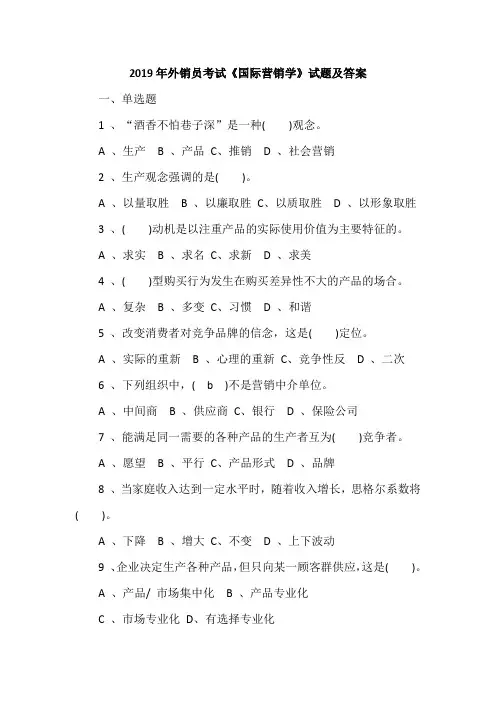
2019年外销员考试《国际营销学》试题及答案一、单选题1 、“酒香不怕巷子深”是一种()观念。
A 、生产B 、产品C、推销 D 、社会营销2 、生产观念强调的是()。
A 、以量取胜B 、以廉取胜C、以质取胜 D 、以形象取胜3 、()动机是以注重产品的实际使用价值为主要特征的。
A 、求实B 、求名C、求新 D 、求美4 、()型购买行为发生在购买差异性不大的产品的场合。
A 、复杂B 、多变C、习惯 D 、和谐5 、改变消费者对竞争品牌的信念,这是()定位。
A 、实际的重新B 、心理的重新C、竞争性反 D 、二次6 、下列组织中,(b)不是营销中介单位。
A 、中间商B 、供应商C、银行 D 、保险公司7 、能满足同一需要的各种产品的生产者互为()竞争者。
A 、愿望B 、平行C、产品形式 D 、品牌8 、当家庭收入达到一定水平时,随着收入增长,思格尔系数将()。
A 、下降B 、增大C、不变 D 、上下波动9 、企业决定生产各种产品,但只向某一顾客群供应,这是()。
A 、产品/ 市场集中化B 、产品专业化C 、市场专业化D、有选择专业化10、按照人口的具体变量细分市场的方法就是()细分。
A 、地理B 、行为C、心理 D 、人口11、处于()的产品,可采用无差异性的目标市场营销策略。
A 、成长期B 、衰退期C、导入期 D 、成熟期12、()调查是为了解市场中出现的有关现象之间的因果关系而进行的专题调查。
A 、探测性B 、描述性C、因果性 D 、预测性13、以现有产品开发新市场,这是()战略。
A 、一体化B 、市场渗透C、市场开发 D 、产品开发14、利用原有市场,采用不同技术开发新产品,这是()战略。
A 、产品开发B 、同心多元化C、综合多元化 D 、水平多元化15、产业用品渠道一般不包括()A 、批发商B 、代理商C、制造商 D 、零售商16、产品价格低,其营销渠道就应()。
A 、长而窄B 、长而宽C、短而窄 D 、短而宽17、生产者在某一地区仅通过少数几个精心挑选的中间商来分销产品,这是()分销策略。
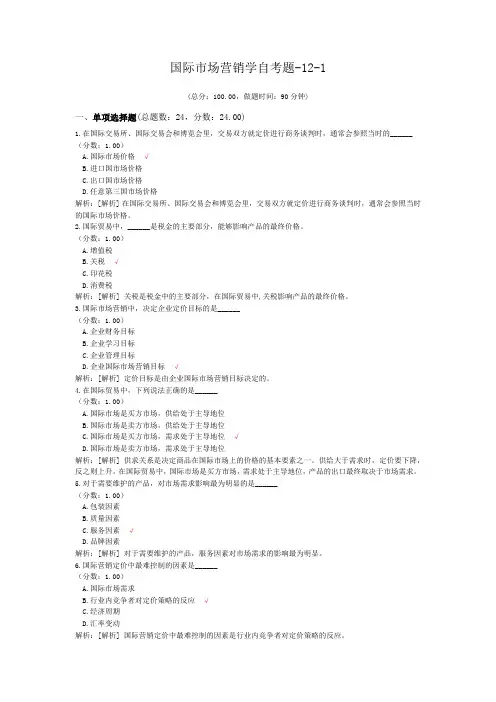
国际市场营销学自考题-12-1(总分:100.00,做题时间:90分钟)一、单项选择题(总题数:24,分数:24.00)1.在国际交易所、国际交易会和博览会里,交易双方就定价进行商务谈判时,通常会参照当时的______ (分数:1.00)A.国际市场价格√B.进口国市场价格C.出口国市场价格D.任意第三国市场价格解析:[解析] 在国际交易所、国际交易会和博览会里,交易双方就定价进行商务谈判时,通常会参照当时的国际市场价格。
2.国际贸易中,______是税金的主要部分,能够影响产品的最终价格。
(分数:1.00)A.增值税B.关税√C.印花税D.消费税解析:[解析] 关税是税金中的主要部分,在国际贸易中,关税影响产品的最终价格。
3.国际市场营销中,决定企业定价目标的是______(分数:1.00)A.企业财务目标B.企业学习目标C.企业管理目标D.企业国际市场营销目标√解析:[解析] 定价目标是由企业国际市场营销目标决定的。
4.在国际贸易中,下列说法正确的是______(分数:1.00)A.国际市场是买方市场,供给处于主导地位B.国际市场是卖方市场,供给处于主导地位C.国际市场是买方市场,需求处于主导地位√D.国际市场是卖方市场,需求处于主导地位解析:[解析] 供求关系是决定商品在国际市场上的价格的基本要素之一。
供给大于需求时,定价要下降,反之则上升。
在国际贸易中,国际市场是买方市场,需求处于主导地位,产品的出口最终取决于市场需求。
5.对于需要维护的产品,对市场需求影响最为明显的是______(分数:1.00)A.包装因素B.质量因素C.服务因素√D.品牌因素解析:[解析] 对于需要维护的产品,服务因素对市场需求的影响最为明显。
6.国际营销定价中最难控制的因素是______(分数:1.00)A.国际市场需求B.行业内竞争者对定价策略的反应√C.经济周期D.汇率变动解析:[解析] 国际营销定价中最难控制的因素是行业内竞争者对定价策略的反应。
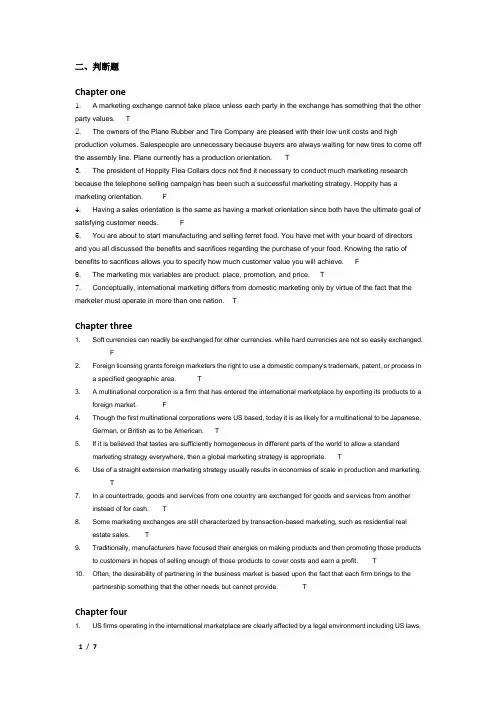
二、判断题Chapter one1. A marketing exchange cannot take place unless each party in the exchange has something that the other party values. T2.The owners of the Plane Rubber and Tire Company are pleased with their low unit costs and high production volumes. Salespeople are unnecessary because buyers are always waiting for new tires to come off the assembly line. Plane currently has a production orientation. T3.The president of Hoppity Flea Collars docs not find it necessary to conduct much marketing research because the telephone selling campaign has been such a successful marketing strategy. Hoppity has a marketing orientation. F4.Having a sales orientation is the same as having a market orientation since both have the ultimate goal of satisfying customer needs. F5.You are about to start manufacturing and selling ferret food. You have met with your board of directors and you all discussed the benefits and sacrifices regarding the purchase of your food. Knowing the ratio of benefits to sacrifices allows you to specify how much customer value you will achieve. F6.The marketing mix variables are product. place, promotion, and price. T7.Conceptually, international marketing differs from domestic marketing only by virtue of the fact that the marketer must operate in more than one nation. TChapter three1. Soft currencies can readily be exchanged for other currencies. while hard currencies are not so easily exchanged.F2. Foreign licensing grants foreign marketers the right to use a domestic company's trademark, patent, or process ina specified geographic area. T3. A multinational corporation is a firm that has entered the international marketplace by exporting its products to aforeign market. F4. Though the first multinational corporations were US based, today it is as likely for a multinational to be Japanese,German, or British as to be American. T5. If it is believed that tastes are sufficiently homogeneous in different parts of the world to allow a standardmarketing strategy everywhere, then a global marketing strategy is appropriate. T6. Use of a straight extension marketing strategy usually results in economies of scale in production and marketing.T7. In a countertrade, goods and services from one country are exchanged for goods and services from anotherinstead of for cash. T8. Some marketing exchanges are still characterized by transaction-based marketing, such as residential realestate sales. T9. Traditionally, manufacturers have focused their energies on making products and then promoting those productsto customers in hopes of selling enough of those products to cover costs and earn a profit. T10. Often, the desirability of partnering in the business market is based upon the fact that each firm brings to thepartnership something that the other needs but cannot provide. TChapter four1. US firms operating in the international marketplace are clearly affected by a legal environment including US laws,international laws, and laws of the host country. T2. Government regulations that tax or otherwise set limits on the number of goods and services by foreignproducers are known as trade barriers. F3. A free trade area extends a customs union by seeking to reconcile all government regulations affecting trade.F4. Trade officials are in full agreement as to the direction the WTO should follow in pursuing its major policyinitiatives. F5. Foreign licensing can build revenues without the capital outlay required for establishment of manufacturingfacilities in a foreign country. T6. The trend toward increased foreign ownership of assets in the United States will probably decline because of theincreased hostility toward and government regulation of foreign- owned businesses operating in the United States. F7. Income left over after an individual pays taxes and purchases the basic necessities of food, clothing and shelter iscalled disposable income. F8. A comprehensive spending pattern shows the percentages of annual family expenditures allotted to generalclasses of goods and services. T9. Import tariffs are the means by which a government controls the in-flow of foreign goods across its borders.T10. Although WTO is a global institutional proponent of free trade, it is not without critics. TChapter five1. Culture is learned behavior passed on from generation to generation, but it is not difficult for the inexperienced oruntrained outsider to fathom. F2. Equality, disadvantaged members of society, safety and health, education and general welfare, pollution aresocial responsibility issues related to community relations. F3. All marketing employees are responsible for setting the ethical tone for the entire marketing organization. F4. Green marketing refers to the development, pricing, promotion and distribution of products that do not harm theenvironment. T5. Water pollution, air pollution, land pollution, safety and health are social responsibility issues related to theenvironment, or green marketing. F6. The vital, critical skill of the global marketer is perception, or the ability to see what is so in a culture. T7. Gestures, carriage, proximity of speakers, eye contact, and smiling all play key roles in a culture's use oflanguage. T8. Every country and culture has a history that will greatly affect both the market and the marketer. T9. Being enthusiastic about a product and having a personal attachment to it are two similar things. F10. Although the hospitality and tourism industries are slightly affected by religious holidays, marketers withproducts related to those industries need to be highly sensitive to this issue. FChapter six1.Early marketing research was fairly sophisticated because statistical techniques were sufficiently refined toproduce high levels of accuracy in research findings. F2.In the event that a new competitor were to enter a market in which you were involved. one question marketingresearch might help answer for you would be “ What must w e do to differentiate our company from our competitor?”T3. A hypothesis is a statement about the relationship among variables that carries clear implications for testing therelationship. It sets the stage for more in-depth research by clarifying what researchers need to test. T4.Trade associations represent an excellent source of private data for particular industries. T5.Sampling is the process of selecting survey respondents or other research participants. Trmation related to global markets is not readily available to American firms seeking to enter foreign markets.The Department of Commerce has only recently begun to collect data to assist firms in this area. F7.Telephone interviews are a suitable method of collecting primary marketing research data all over the worldbecause the telephone is now the universal appliance found in every home. F8.An MIS is a planned, computer-based system designed to provide managers with a continual flow of informationrelevant to specific decision areas. T9.An MIS gathers data only from inside the organization and processes it to product relevant marketing information.Fputers have automated the buying process at large retailers, opening new channels for gathering marketinginformation. TChapter seven1. The target market for a product is the specific segment of consumers most likely to purchase a particular product.T2. The division of the total market into smaller, relatively homogeneous groups is called market selectivity. F3. The number and size of the market segments chosen by a firm must not exceed its marketing capabilities.T4. Marketers must identity segments sufficiently small enough to capture in their entirely and effectively promote toas an exclusive source of some needed product. F5. Marketers are often able to identify totally homogeneous markets segments;there are seldom majordifferences among the members of a target market group. F6. The information, analysis, and forecasts accumulated through the entire market segmentation decision processallow management to assess the potential for achieving company goals and to justify committing resources to develop one or more segments. T7. Using differentiated marketing, Culture's Edge can market a wide range of trips exploring ethnic, cultural, andlifestyle-based issues that together appeal to the majority of vacation travelers, yet sell them in such a way as to appeal to individual parts of that market. T8. Colorado River White Water Raft Tours may take your breath away, but they don't take American Express! Thisrepresents an attempt by Visa Card to position itself with to one of its competitors. T9. The firm's segmentation strategy may change as its product progresses through the stages of the life cycle.During the early stages, undifferentiated marketing might effectively support the firm's attempt to develop initial demand for the product. T10. Marketers can create a competitive positioning map from information solicited from competitors or from publicdatabases that track consumer attitudes, opinions, and interests. FChapter eight1. The principal disadvantage of licensing is that it can be a very limited form of participation. T2. Exporting is the most traditional and well-established form of operating internationally. T3. Licensing, joint ventures and importing are points and tools for global market entry and expansion. F4. Large-scale direct expansion may be less expensive and a major commitment of managerial time and energy isunnecessary. F5. Management contracting includes the sharing of risk and the ability to combine different value chain strengths.F6. One of the advantages of joint venture is better control of sales activities compared with other forms ofparticipation in foreign markets. F7. Licensing is an alternative entry and expansion strategy with considerable appeal. T8. Direct exporting lakes place through sales by foreign distributors, sales agents, and overseas subsidiaries. T9. As export merchants, they are essentially acting as domestic wholesalers operating in foreign markets throughtheir own sales agents or salesforce. T10. International trading companies tend to be large-scale manufacturers and merchants and they are involved inwholesale and retail distribution. TChapter nine1. The final step in the marketing control process is to compare actual performance and standards. F2. In a period of recovery, the best marketing strategy for Electrolux would he characterized by flexibility. F3. In the beer industry, a few large brewers supply the majority of the market. The brewing industry is an example ofthe competitive structure : Monopolistic Competition. F4. Post Office Parcel Services firms would most likely have a monopoly for its competitive environment. F5. Essex Office Products has decided to use a particular competitive tool that it feels will have a major impact. Itsconsultant, Dr. Bell, contends that this particular approach is the one most easily copied by the firm's competitors.The tool in question is: market segmentation. F6. A small hardware store whose only competitor is a huge discount store would be least likely to use thecompetitive tool distribution. F7. Customer value analysis refers to analysis conducted to determine what benefits target customers value and howthey rate the relative value of various competitors’ offers. T8. Some basic competitive positioning strategies that companies can follow are:overall cost leadership,differentiation, and focus. T9. While trying to expand total market size, the leading firm must constantly protect its current business againstcompetitors’ attacks. T10. Competitor-centered company is a company whose moves are mainly based on competitors’actions andreactions; it spends most of its lime Cracking compelilors1 moves and market shares and trying to find strategies to counter them. TChapter ten1. Ford Motor Company’s marketing strategy in Europe reflects a company that saw Europe as distinctlyfragmented into narrow markets within their specific nation states. F2. The United States can be considered as a good example for regional economic integration. T3. Regional economic integration is the political and economic agreement among countries that give preference tomember countries to that agreement. T4. Global strategic partnerships will become less important in the Asia-Pacific regions. F5. The WTO allows a departure from its policy to grant the same favorable trade conditions to all WTO members inthe case of regional trade agreements ( RTAs ). T6. The goal of a free-trade area ( FTA ) is to abolish work permits among its members. F7. Collaborative agreements can be used to refer to linkages between companies to pursue a common goal. T8. Custom unions levy a common external tariff on goods being imported from nonmembers. T9. Changes in the political, economic, socio-cultural, and technological environments are leading to new strategiesin global competition. T10. Trade creation allows consumers access to more goods at lower prices and is considered a major benefit ofregional economic integration. TChapter eleven1. A company's research and development process is the only way for them to develop new products. F2. The step-by-step new product development process explained in the text has been used by so many companiesover so many years that it is almost failure-proof today. F3. The first full-scale working product from a concept is called a “prototype. “T4. When a product has been in the maturity stage of the product life cycle for a period of time, marketing managershave pretty well lost any control of the product to the competitive vagaries that characterize that stage. F 5. Brand equity is the added value a given brand name gives to a product beyond the functional benefits provided.F6. The marketing objective for a product in the introduction stage of the product life cycle (PLC ) is to promoteconsumer awareness and gain trial. T7. The goal of VCR manufacturers’advertisement is to maintain brand loyalty and market share; the productcategory is in the introduction stage of its product life cycle. F8. Products that are used directly in the production of a final product but are not easily identifiable are categorized ascomponent parts. T9. Machines and tools used in a production process but not as part of final products are classified as componentparts. F10. Routinely purchased items that do not become part of the final physical product and are treated like expenseitems rather than capital goods are classified as supplies and services. F11. A desirable feature for a brand name is it can be used as the general name for all products in the category.FChapter twelve1. Pricing and price competition is the number-one problem facing most marketing executives. T2. External environmental factors have the greatest effect on pricing decisions. F3. “ Forward buying” means that w holesalers stock up on far more merchandise than they can sell duringmanufacturers’ price promotions, and then resell to customers at higher prices after the promotion is over. T4. A firm’s total cost is made up of two components: direct costs and variable costs. F5. “Optional product pricing” is adding services to the base product to differentiate it from competitors and justifyhigher prices and margins. F6. The fact that prices are usually higher ( often substantially higher ) in foreign markets is called price escalation.T7. The Robinson-Patman Act seeks to prevent unfair price discrimination by ensuring that all members at a givenlevel in the channel of distribution are offered the same terms by the seller. TChapter thirteen1. A wholesaler is a marketing intermediary that takes title to the goods it sells and then distributes those goods toretailers, other distributors, and sometimes consumers. T2. A generalization that is usually true of marketing channel length is: The more standardized the product. theshorter the channel. F3. When Coca-Cola and Nestle formed a joint venture to market ready-to-drink coffee and tea worldwide, theyformed a horizontal marketing system. T4. The use of two or more marketing channels to reach the same target market is referred to as dual channeling.F5. Forcing a dealer to take the full line of products in order to get a strong brand is illegal. F6. Once a firm has defined its channel objectives, it should identify its channel alternatives, i. e. the types andnumber of intermediaries and the functions that each intermediary should perform. T7. Third party logistics basically means that firms outsource logistical tasks to independent providers who may adoptone or all of the functions required to get clients’products to market. T8. A direct-marketing channel consists of a manufacturer selling directly to the final customer. T9. Intensive is the type of distribution where there is the use of more than a few but less than all of the intermediarieswho are willing to carry a particular product. F10. When retailers develop private brands to compete with producers’ brands, the type of marketing channel conflictis vertical. TChapter fourteen1. A company's integrated marketing communications mix also goes by the name of promotional mix. T2. Contests, free samples, and coupons are examples of personal selling. F3. Non-personal communication channels carry messages without personal contact or feedback. T4. ACD Corporation sells technical products and its customers are concentrated in a small geographic area. Thecompany will use advertising the most. F5. Companies that use the affordable method base their promotion budget on a certain percentage of current orforecasted sales and / or a percentage of the sales price. F6. Mast larger companies combine push and pull strategies to move their products from the manufacturer to the finalconsumer. T7. When Gin Toy advertises a toy on Saturday-morning television and tells children to ask for the product at theirfavorite toy store, it is implementing a pull strategy in its promotion mix. T8. While the promotion mix is the company's primary communication process, the entire marketing mix must becoordinated for the greatest communication impact. T9. If a push policy is employed in promoting a product, the firm promotes only to the next institution down themarketing channel. T10. A television commercial demonstrating the versatility of the Mercedes sports utility vehicle would best beclassified as product advertising. T11. The main disadvantage with the percentage-of-sales method of setting advertising budgets is that it reversescause and effect. T12. An evaluation of media impact will help determine the media types to be used. T13. Marketers have found much success using standardized ads in their global advertising. FChapter sixteen1. The Matrix organizational structure uses teams whose members report to two or more managers. T2. Small and medium-sized firms most commonly use matrix organizational structure. F3. The process of creating an organization’s structure is called organizing. T4. A marketing control process provides feedback on how well a marketing strategy is working in the marketplace.T5. With regard to “marketing organization”, firms that focus their attention on developing a coordinated marketingmix for each brand are examples of matrix organizations. F6. The hard task of selecting an overall company strategy for long-run survival and growth is called marketingcontrol. F7. The marketing audit is a comprehensive, periodic examination of a company's environment, objectives,strategies, and activities to determine problem areas and opportunities. T8. A marketing audit is a control device used primarily by large corporations to study past performance. F9. Gabble’s Granola has set up a committee to formally study its current status and capabilities and its futureexpectations. Gabble's Granola is conducting a marketing audit. F10. A marketing audit should evaluate a company's whole marketing program on a regular basis. T11. A planning manager from corporate headquarters finds that his eastern region has no effective method ofallocating resources or evaluating goals and performance of the marketing organization. He suggests that the region should prepare a marketing audit. T12. A marketing audit should be conducted by the person who is most familiar with each of the firm's marketing plans.F13. A marketing audit should help determine if the company's marketing objectives are reasonable. TChapter seventeen1. E-marketing is a generic term used to describe all marketing channels facilitated by the Web. T2. One reason so many companies and government agencies are interested in the development of extensiveelectronic commerce is because of its potential to shift or eliminate costs. T3. Electronic commerce has become collaborative commerce. T4. China still takes the lead of the e-commerce both in technology and practices. F5. In the 1990s, the Chinese government enacted *'golden bridge”, "gold card" and "golden gate” projects topromote e-commerce. F6. Traditional marketing, from a communications standpoint, is primarily a one-way medium. TChapter eighteen1. Direct marketing involves one-way connections aimed at consumers. F2. Direct marketing is convenient, easy, and private. T3. Direct marketing is poor in building customer relationships. F4. Internet marketing has the advantage of reducing costs. T5. Direct marketing sales have grown at about 4% annually. F6. A customer mailing list and a customer database are the same. F7. Companies use their databases to identify prospects. T8. Telemarketing is the major direct marketing communication tool. T9. Direct mail marketing involves only selling catalogs to customers. F10. Three new forms of direct mail are fax, e-mail, and voice mail. T。
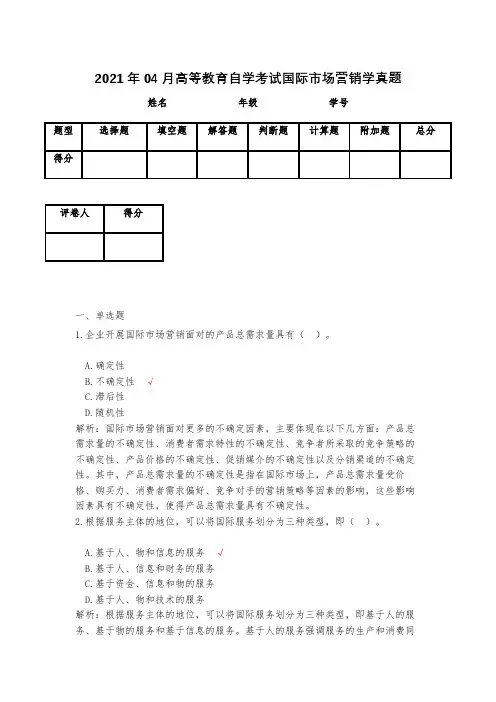
2021年04月高等教育自学考试国际市场营销学真题姓名年级学号题型选择题填空题解答题判断题计算题附加题总分得分评卷人得分一、单选题1.企业开展国际市场营销面对的产品总需求量具有()。
A.确定性B.不确定性√C.滞后性D.随机性解析:国际市场营销面对更多的不确定因素,主要体现在以下几方面:产品总需求量的不确定性、消费者需求特性的不确定性、竞争者所采取的竞争策略的不确定性、产品价格的不确定性、促销媒介的不确定性以及分销渠道的不确定性。
其中,产品总需求量的不确定性是指在国际市场上,产品总需求量受价格、购买力、消费者需求偏好、竞争对手的营销策略等因素的影响,这些影响因素具有不确定性,使得产品总需求量具有不确定性。
2.根据服务主体的地位,可以将国际服务划分为三种类型,即()。
A.基于人、物和信息的服务√B.基于人、信息和财务的服务C.基于资金、信息和物的服务D.基于人、物和技术的服务解析:根据服务主体的地位,可以将国际服务划分为三种类型,即基于人的服务、基于物的服务和基于信息的服务。
基于人的服务强调服务的生产和消费同时交互进行,顾客作为消费者同时也是服务生产过程的参与者,如医疗、餐饮服务等;基于物的服务则强调服务公司需要借助特殊的载体来为顾客提供服务,如物流、仓储服务等;基于信息的服务是指服务公司通过信息处理和传送来为顾客提供服务,如金融、企业咨询等。
3.对于企业选择进入国际市场的各种战略,风险最高的是()。
A.出口B.直接投资√C.战略联盟D.许可协议解析:企业进入国际市场时,有四种战略可供选择:出口、许可协议、国际战略联盟和对外直接投资。
其中,对外直接投资是指一国的企业或个人通过在国外设立子公司或分公司,通过购买、参与当地企业的股份,直接在海外从事生产、销售和其他经营活动的投资形式,也是四种战略中面临风险最高的战略。
按企业对国外子公司拥有股权份额的程度,对外直接投资表现为合资经营和独资经营两种基本形式。
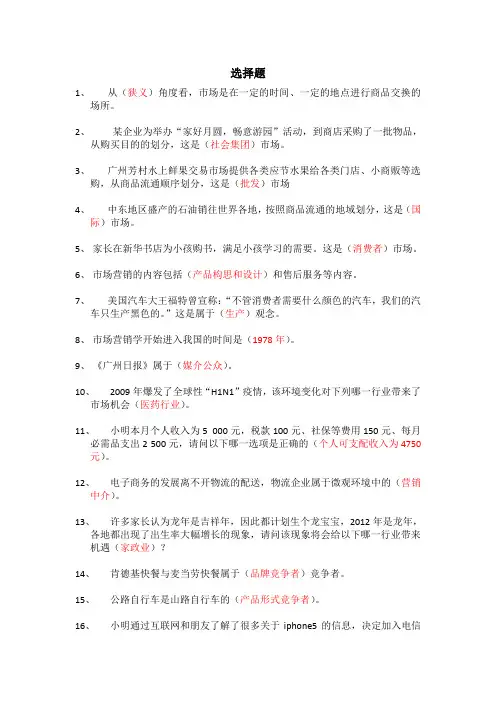
选择题1、从(狭义)角度看,市场是在一定的时间、一定的地点进行商品交换的场所。
2、某企业为举办“家好月圆,畅意游园”活动,到商店采购了一批物品,从购买目的的划分,这是(社会集团)市场。
3、广州芳村水上鲜果交易市场提供各类应节水果给各类门店、小商贩等选购,从商品流通顺序划分,这是(批发)市场4、中东地区盛产的石油销往世界各地,按照商品流通的地域划分,这是(国际)市场。
5、家长在新华书店为小孩购书,满足小孩学习的需要。
这是(消费者)市场。
6、市场营销的内容包括(产品构思和设计)和售后服务等内容。
7、美国汽车大王福特曾宣称:“不管消费者需要什么颜色的汽车,我们的汽车只生产黑色的。
”这是属于(生产)观念。
8、市场营销学开始进入我国的时间是(1978年)。
9、《广州日报》属于(媒介公众)。
10、2009年爆发了全球性“H1N1”疫情,该环境变化对下列哪一行业带来了市场机会(医药行业)。
11、小明本月个人收入为5 000元,税款100元、社保等费用150元、每月必需品支出2 500元,请问以下哪一选项是正确的(个人可支配收入为4750元)。
12、电子商务的发展离不开物流的配送,物流企业属于微观环境中的(营销中介)。
13、许多家长认为龙年是吉祥年,因此都计划生个龙宝宝,2012年是龙年,各地都出现了出生率大幅增长的现象,请问该现象将会给以下哪一行业带来机遇(家政业)?14、肯德基快餐与麦当劳快餐属于(品牌竞争者)竞争者。
15、公路自行车是山路自行车的(产品形式竞争者)。
16、小明通过互联网和朋友了解了很多关于iphone5的信息,决定加入电信的网络,他去到电信营业厅此时他的购买行为属于(全确定型)。
17、小飞去大超市想买一款去头屑的洗发水,但是超市里去头屑的洗发水很多,他一下子迷惑了,不知道该买哪个牌于的洗发水,小飞的购买行为是属于(半确定型)的购买行为。
18、人们特有的信仰、偏好、禁忌等形成的一种亚文化叫做(宗教亚文化)。
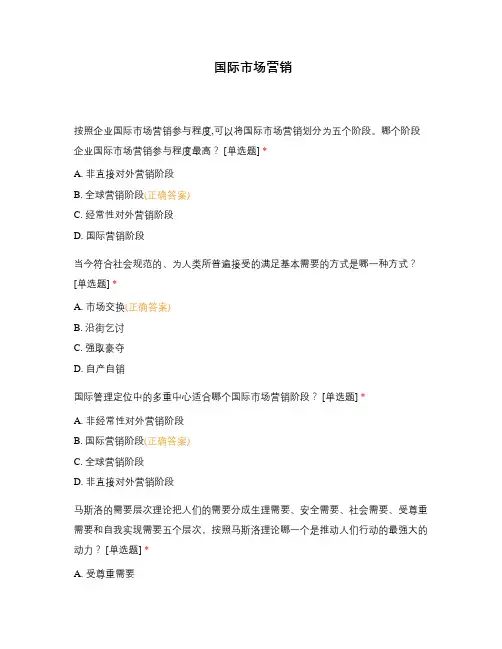
国际市场营销按照企业国际市场营销参与程度,可以将国际市场营销划分为五个阶段。
哪个阶段企业国际市场营销参与程度最高? [单选题] *A. 非直接对外营销阶段B. 全球营销阶段(正确答案)C. 经常性对外营销阶段D. 国际营销阶段当今符合社会规范的、为人类所普遍接受的满足基本需要的方式是哪一种方式?[单选题] *A. 市场交换(正确答案)B. 沿街乞讨C. 强取豪夺D. 自产自销国际管理定位中的多重中心适合哪个国际市场营销阶段? [单选题] *A. 非经常性对外营销阶段B. 国际营销阶段(正确答案)C. 全球营销阶段D. 非直接对外营销阶段马斯洛的需要层次理论把人们的需要分成生理需要、安全需要、社会需要、受尊重需要和自我实现需要五个层次,按照马斯洛理论哪一个是推动人们行动的最强大的动力? [单选题] *A. 受尊重需要B. 生理需要(正确答案)C. 自我实现需要D. 社会需要哪一种国际管理定位对企业的国际化经验和人才要求最高? [单选题] *A. 全球中心(正确答案)B. 区域中心C. 多重中心D. 种族中心是谁提出的折中理论? [单选题] *A. 玻尔马特B. 詹姆斯C. 海默D. 邓宁(正确答案)以下哪一个不是市场营销中“市场”所特别强调的? [单选题] *A. 购买力B. 需求C. 消费者D. 交易地点(正确答案)以下哪一个属于企业相对的可控因素? [单选题] *A. 东道国环境B. 全球环境C. 母国环境D. 渠道(正确答案)折中理论认为企业必须具备哪些优势才可以进行国际直接投资? [单选题] *A. 同时拥有三种优势(正确答案)B. 内部化优势C. 企业优势D. 区位优势自我参照准则是国际管理定位中哪一种认识世界的方法? [单选题] *A. 区域中心B. 多重中心C. 全球中心D. 种族中心(正确答案)“某一中国企业在美国投资建厂,并将该生产的产品在美国市场销售。
”这不属于国际市场营销。
[单选题] *正确答案:错误(正确答案)产品的价值是由消费者的评价和选择决定的,而不是生产成本所决定的。
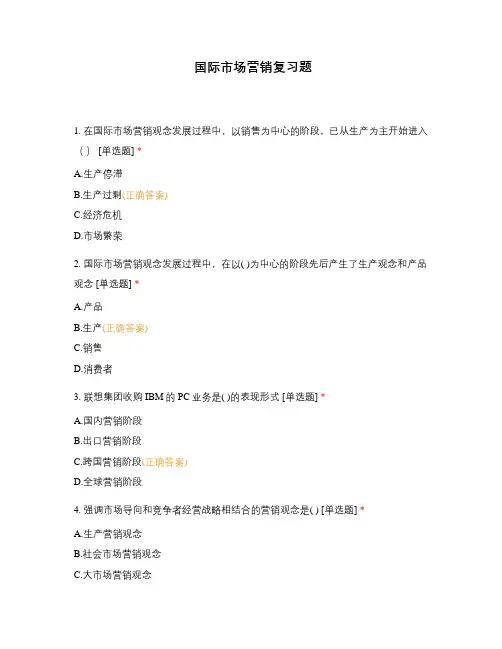
国际市场营销复习题1. 在国际市场营销观念发展过程中,以销售为中心的阶段,已从生产为主开始进入() [单选题] *A.生产停滞B.生产过剩(正确答案)C.经济危机D.市场繁荣2. 国际市场营销观念发展过程中,在以( )为中心的阶段先后产生了生产观念和产品观念 [单选题] *A.产品B.生产(正确答案)C.销售D.消费者3. 联想集团收购IBM的PC业务是( )的表现形式 [单选题] *A.国内营销阶段B.出口营销阶段C.跨国营销阶段(正确答案)D.全球营销阶段4. 强调市场导向和竞争者经营战略相结合的营销观念是( ) [单选题] *A.生产营销观念B.社会市场营销观念C.大市场营销观念D.市场营销观念(正确答案)5. 海尔在世博会期间50多款低碳节能的白色小家电产品,这属于( )营销。
[单选题] *A.关系营销B.绿色营销(正确答案)C.网络营销D.直复营销6. 一个国家生活必需品的市场潜量主要取决于( ) [单选题] *A.人口的规模(正确答案)B.人口的分布C.人口的增长率D.人口的结构7. 国际市场营销与国内市场营销相比,其表现为( ) [单选题] *A.两者的理论来源和基础相同(正确答案)B.两者的营销方式相同C.两者面对的环境相同D.两者的营销难度相同8. 国际市场营销主要着眼于( ) [单选题] *A.国家利益B.地区利益C.企业利益(正确答案)D.消费者利益9. 市场构成要素有( ) *A.人口(正确答案)B.买卖方C.购买力(正确答案)D.收入E.购买欲望(正确答案)10. 决定国际市场营销复杂性的两个主要因素是( ) *A.全球经济环境B.全球化竞争(正确答案)C.全球环境(正确答案)D.全球政治因素E.全球人口因素11. “以产定销”的国际市场营销观念有( ) *A.市场营销观念B.产品观念(正确答案)C.绿色营销观念D.推销观念(正确答案)E.全球营销观念12. 企业开展国际市场营销活动的驱动力主要有( ) *A.扩大市场(正确答案)B.获取竞争优势(正确答案)C.获取更多利润(正确答案)D.获取国内稀缺资源(正确答案)E.企业获得更大声望13. 下列属于国际市场营销基本要素的是 ( ) *A.确定国际目标市场顾客需求(正确答案)B.满足国际目标市场顾客需求(正确答案)C.超越国际市场竞争者D.协调国际市场营销活动(正确答案)E.确认国际目标市场营销环境限制因素(正确答案)14. 企业的全球化决策包括( ) *A.企业的战略全球化决策(正确答案)B.企业组织全球化决策(正确答案)C.企业的产品全球化决策(正确答案)D.企业的品牌全球化决策(正确答案)E.企业的生产全球化决策15. 企业在多个国家进行营销活动,在许多国家设立了子公司进行生产经营活动,同时这些子公司之间没有多少联系,这个企业处于出口营销阶段。
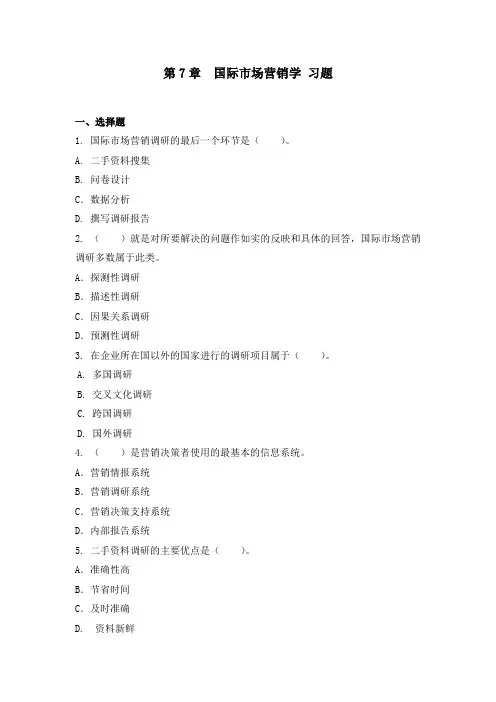
第7章国际市场营销学习题一、选择题1. 国际市场营销调研的最后一个环节是()。
A. 二手资料搜集B. 问卷设计C.数据分析D. 撰写调研报告2. ()就是对所要解决的问题作如实的反映和具体的回答,国际市场营销调研多数属于此类。
A.探测性调研B.描述性调研C.因果关系调研D.预测性调研3. 在企业所在国以外的国家进行的调研项目属于()。
A. 多国调研B. 交叉文化调研C. 跨国调研D. 国外调研4. ()是营销决策者使用的最基本的信息系统。
A.营销情报系统B.营销调研系统C.营销决策支持系统D.内部报告系统5. 二手资料调研的主要优点是()。
A.准确性高B.节省时间C.及时准确D. 资料新鲜6. 对国际市场营销企业来说,第四大资源是()。
A.人B.财C.物D.信息7. 国际营销企业实行在目的市场营销调研的主要优点在于()。
A.可及时准确地得到所需信息B.目标更加明确C.降低调研成本D.节省时间8. 二手资料经过多次转载容易出错,必须注意其()。
A.充分性B.相关性C.准确性D.滞后性9. 以下哪种途径获得的信息属于二手资料?()A.通过访谈B.通过调查问卷C.通过市场试验D.通过报纸、刊物10. 某企业为评价其广告效果对消费者的态度和行为进行的调研是()。
A. 产品调研B. 促销调研C. 价格调研D. 分销渠道调研11. 某国际企业为提高其老年市场的占有率,计划进行一次营销调研,最不合适的访问法是()。
A.人员访问B.电话访问C.邮寄访问D.网上访问12. 在设计问卷时,问题的顺序原则上是()。
A.先易后难B.先难后易C.难易交替D.无所谓13. 某国际企业开展了一次市场调研,以能更好地利用持续变化的市场中出现的机会,这属于营销调研的()A.描述功能B.预测功能C.诊断功能D.控制功能14. 某国际企业开展了一次市场调研,以能更好地利用持续变化的市场中出现的机会,这属于营销调研的()。
A.描述功能B.预测功能C.诊断功能D.控制功能15. 国际市场营销调研划分为探测性调研、描述性调研、预测性调研和因果性调研,其划分的标准是()。
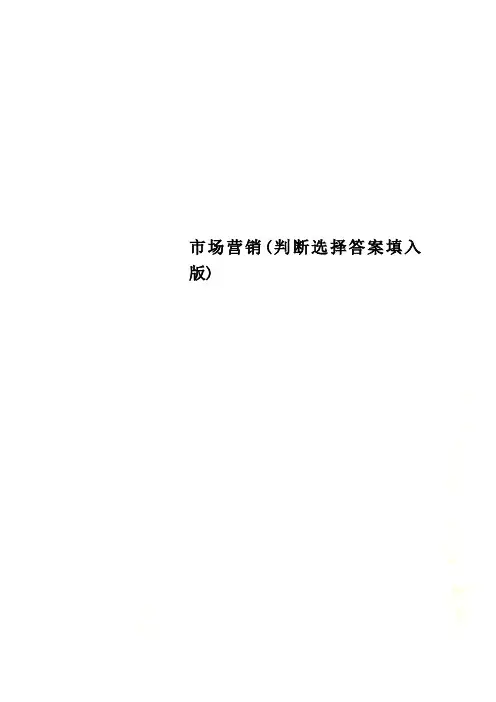
市场营销(判断选择答案填入版)英语专业2012级市场营销学原理复习题一、名词解释市场调研促销市场挑战者品牌促销组合产品生命周期市场定位公众市场机会产品观念需求价格弹性商标消费者市场顾客让渡价值市场追随者公共关系产品生命周期分销渠道绿色营销销售促进二、判断题1、针对过量需求,企业营销管理的任务是“反市场营销”。
2、一般来说,市场占有率越低,这个单位盈利能力越强。
3、恩格尔系数越大,生活水平越低;反之,恩格尔系数越小,生活水平越高。
√4、就卖主而言,消费者市场是法人市场,组织市场是公家市场。
5、即使不支出任何的营销费用,市场对某种产品仍然存在一个基本的需求量。
√6、企业采用服务差别化的市场定位战略,就可以不再追求技术和质量的提高。
7、企业高层领导人员,如果没有产品整体概念,就不可能有现代市场营销观念。
√8、驰名商标的知名度和影响力关键取决于国家商标局的认可。
9、采用运费免收定价会使产品成本增加,不但给企业市场渗透带来困难,甚至难以在激烈的市场竞争中站住脚。
10、如果存货、仓储和运输单位的决策中心的经营状况良好,并且都能降低个别单位的成本,总系统的物流成本降到最低限度,那么该物流系统是有效的。
11、一般来说,管理跨度与管理层次互为正比关系。
12、国际市场营销中,公关促销的作用日益加强,特别是进入一些开放程度较高的市场,公共关系作用更直接影响企业的国际市场进入。
13、市场营销观念的一个重要特征就是将企业利润作为优先考虑的事情。
√14、企业可以按自身的意愿和要求随意改变市场营销环境。
15、恩格尔系数越高,人们的生活水平越高;反之,恩格尔系数越小,人们的生活水平越低。
16、一个设计出色的产品包装,不但可以保护产品,还可以增加商品本身的价值,进而增加企业的利润。
√17、对于价格较低、技术性弱、买主多而分散的消费品适宜采用广告方式促销;而对于价格昂贵、技术性强、买主少而集中的工业用品,适宜采用人员推销方式促销。
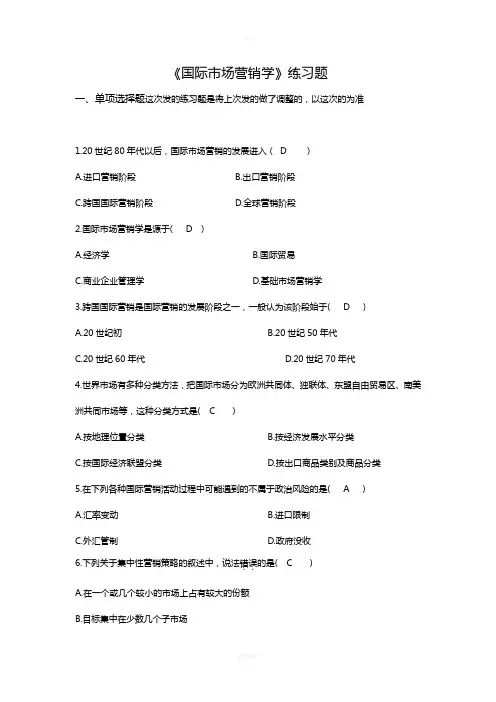
《国际市场营销学》练习题一、单项选择题这次发的练习题是将上次发的做了调整的,以这次的为准1.20世纪80年代以后,国际市场营销的发展进入(D )A.进口营销阶段B.出口营销阶段C.跨国国际营销阶段D.全球营销阶段2.国际市场营销学是源于( D )A.经济学B.国际贸易C.商业企业管理学D.基础市场营销学3.跨国国际营销是国际营销的发展阶段之一,一般认为该阶段始于( D )A.20世纪初B.20世纪50年代C.20世纪60年代D.20世纪70年代4.世界市场有多种分类方法,把国际市场分为欧洲共同体、独联体、东盟自由贸易区、南美洲共同市场等,这种分类方式是( C )A.按地理位置分类B.按经济发展水平分类C.按国际经济联盟分类D.按出口商品类别及商品分类5.在下列各种国际营销活动过程中可能遇到的不属于政治风险的是( A )A.汇率变动B.进口限制C.外汇管制D.政府没收6.下列关于集中性营销策略的叙述中,说法错误的是( C )..A.在一个或几个较小的市场上占有较大的份额B.目标集中在少数几个子市场C.在较大的市场上占有一个较小的市场份额D.适用于资源有限的企业7.企业只推出单一产品,运用单一的市场营销组合,力求在一定程度上适合尽可能多的顾客的需求,这种战略是( A )A.无差异市场营销战略B.密集市场营销战略C.差异市场营销战略D.集中市场营销战略8.下列属于产品附加利益层的是( D )A.产品的功能和效用B.产品的品牌和商标C.产品的包装和色彩D.送货、安装、上门服务9.某企业集团从生产保健品转向房地产开发,其产品市场的进入模式是( D )A.产品开发型模式B.市场开发型模式C.市场渗透型模式D.多种经营型模式10.以向企业管理人员提供有关销售、成本、存货、现金流量、应收账款等企业经营现状信息为主要工作任务的系统是市场营销信息系统中的( D )A.市场营销情报系统B.市场决策支持系统C.市场营销分析系统D.内部报告系统11.在国际营销活动中,遇见的最严重的政治风险是( C )A.外汇管制B.劳工政策C.没收D.进口限制12.国际市场宏观细分的首要步骤是( A )A.确定细分标准B.初步划分子市场C.分析初分子市场D.选择易进入的子市场13.差异性营销策略的优点是( B )A.实现规模经济,降低生产和营销成本B.增加企业竞争能力,扩大销售额C.集中力量向某一特定子市场提供最好服务D.适用于资源比较有限的企业14.适合选择短渠道销售决策的产品是( B )A.服务要求不高的产品B.销售数量大、购买次数少的产品C.企业销售力量较弱的产品D.重量轻、体积小的产品15.产品处于成长期和成熟期阶段所采用的广告策略主要是( C )A.告知性广告B.说服性广告C.提醒性广告D.让利性广告16.目标市场是指企业所选定的( B )A.销售地区B.消费者群体C.销售渠道D.销售产品17.在商品价格构成要素中,最基本、最主要的因素是( A )A.成本B.需求C.供给D.购买力18.在分析国际市场政治环境时,衡量政治不稳定性的指标除了文化分裂外,还有( D )A.没收B.征用C.宗教冲突D.政权的更迭率19.如实反映企业经营状况的调查研究属于(B )A.探索性研究B.描述性研究C.因果性研究D.预测性研究20.由调查人通过亲自观看或用仪器进行记录的一种调查方法是( B )A.询问法B.观察法C.实验法D.问卷法21.某产品在市场上普及并逐渐达到饱和,销售量趋于稳定,这说明该产品处于产品生命周期中的( C )A.投入期B.成长期C.成熟期D.衰退期22.企业各产品线中产品项目的数目的平均数称为产品组合的( C )A.广度B.长度C.深度D.密度23.促销活动的首要任务是( D )A.推销产品B.留住顾客C.树立形象D.传递信息24.以自己的名义在本国市场上购买商品,再卖给国外买主的贸易商,统称为(C )A.出口代理商B.出口佣金商C.出口商D.企业自设出口机构25.从企业微观经济分析,市场的构成要素有消费者、欲望和( D )A.商品B.货币C.收入D.购买力26.国际市场营销主要着眼于(C )A.国家利益B.地区利益C.企业利益D.消费者利益27能够反映一个国家或地区经济状况和金融政策的综合指标是( C )A.自然资源B.基础设施C.通货膨胀率D.外国投资状况28.对企业市场营销活动中因自变量的变化引起因变量变化的关系进行的研究是( C )A.探索性研究B.描述性研究C.因果性研究D.预测性研究29.国际市场宏观细分标准中,最常用的细分标准是( A )A.地理标准B.文化标准C.经济标准D.政治和法律标准30.随行就市定价法属于( C )A.成本导向定价法B.需求导向定价法C.竞争导向定价法D.心理导向定价法31、以“新产品—现有需求—国际市场”为基本思路的国际产品市场进入模式是( C )A.多种经营型模式B.市场渗透型模式C.新产品开发型模式D.市场开发型模式32.产品的功能和效用属于整体产品概念中的( B )A.产品附加利益层B.产品核心层C.产品有形特征层D.产品无形特征层33.国际市场的“产品—市场矩阵”中,基于“现有产品—新需求—国际市场”的营销模式是( C )A.市场渗透模式B.产品开发模式C.市场开发模式D.多种经营模式34.顾客需求的差异性理论是( C )A.商品差异性的基础B.市场差异性的基础C.市场细分的基础D.消费品细分的基础35.产品生命周期中,基本特征为销量低且增长缓慢时,说明产品处于( A )A.投入期B.成长期C.成熟期D.衰退期36.针对消费者的消费心理,可采用的定价策略是( C )A.盈亏平衡定价法B.边际成本定价法C.尾数定价法D.平均成本定价法产品所有权,在规定条件下向国外市场销售商品的中间商是( A )37.不拥有...A.出口代理商B.出口经销商C.出口采购商D.出口经纪人38.国际市场营销与国际贸易都有的工作是( B )A.促销B.组织进出口业务C.国际上商品交换D.产品开发39.如果需要把本公司具有优势的知识和技能进行国际转移,其主要媒介是(B )A.出口打入模式B.合同打入模式C.投资打入模式D.间接出口40.产品的维护属于( D )A.产品的核心层B.产品的有形特征层C.产品的延伸层D.产品附加利益层41.美国通用汽车在中国大陆有“别克”、“雪佛兰”等不同的品牌号,这种决策是( C )A.统一品牌决策B.分类品牌决策C.多品牌决策D.主、副品牌决策所有权的是(C )42.在商品流通过程中,对商品没有..A.中间商B.经销商C.代理商D.消费者43.所谓渠道管理的中心任务就是要( B )A.降低成本B.解决矛盾C.提高效率D.促进协调44.在制定国际市场促销策略时,最基本的决策是( B )A.决定促销在国际营销中的强度B.识别/估测目标受众C.提出购买建议D.决定最优促销组合45.下列促销手段中,属于营业推广的是( C )A.广告B.人员推销C.有奖销售D.公共关系46.下列关于影响国际市场销售渠道决策因素的说法中,正确的是( B )A.产品单价越低,越应选择短渠道B.新产品问市之初应选择短渠道C.体积大的重型产品应选择长渠道D.技术性强的产品应选择长渠道47.当商品的需求弹性系数E D值>l时,表明该商品是( A )A.富有弹性B.缺乏弹性C.无弹性D.不能确定弹性48.企业的订货、销售量、生产量、价格、存货等信息属于( C )A.市场情报系统B.市场运筹学系统C.内部记录系统D.国际市场研究系统49.将公司的产品在目标国家之外制造,然后运往目标国家市场销售,这种进入国际市场的式称为( D )A.契约进入模式B.投资进入模式C.产品进入模式D.出口进入模式50.产品的品质和价格属于( B )A.产品核心层B.产品有形特征层C.产品无形特征层D.产品附加利益层51.适宜采用“生产者→零售商→消费者”销售渠道的产品是( B )A.农产品类B.汽车类C.日用品类D.能源类52.短渠道策略适宜于(A )A.销售量很大、购买次数少的市场B.销售量很大、购买次数多的市场C.销售量很少、购买次数少的市场D.销售量很少、购买次数多的市场53.对于顾客挑选性强、注重品牌商标的产品,其销售渠道宽度应选择的策略是( D )A.广泛销售策略B.密集销售策略C.选择性销售策略D.独家销售策略54.通货膨胀对于国际营销决策影响最大的是( B )A.产品决策B.定价决策C.分销决策D.促销决策55.如实了解企业产品销售增长率状况的市场研究属于( B )A.探索性研究B.描述性研究C.因果性研究D.预测性研究56.某汽车制造厂有载重车、牵引车、小轿车等产品线,则其产品组合的宽度为( C )A.1B.2C.3D.457.在世界市场中处于中等竞争地位的企业常采用的跨国公司市场竞争战略是( C )A.市场领导者战略B.市场挑战者战略C.市场追随者战略D.市场后起者战略58.如果某个国家规定商标所有权以最先注册者优先取得,则这个国家采用的法律是( D )A.国际法系B.国际商标法系C.习惯法系D.成文法系59.为了明确某一问题的性质、情况和原因等而进行的专项研究属于( A ) A.探索性研究B.描述性研究C.因果性研究D.预测性研究60.某产品的销量迅速增长,企业开始盈利,竞争者纷纷加入,这说明该产品处于产品生命周期中的( B )A.投入期B.成长期C.成熟期D.衰退期61.企业生产或经营的产品线数目称为产品组合的( A )A.宽度B.长度C.深度D.密度62.适宜市场追随者采用的定价策略是( D )A.薄利多销策略B.按质论价策略C.最优价格策略D.随行就市策略63.较少采用人员推销方式进行促销的产品是( A )A.低价消费品B.高价消费品C.低价工业品D.高价工业品64.国际市场营销渠道是指商品从一个国家的生产企业流向( B ) A.国外供应商的流程B.国外最终消费者或用户的流程C.国外代理商或经纪人的流程D.国外生产企业的流程65.下列定价法中不属于心理导向定价策略的是( B )...A.声望定价法B.整数定价法C.优质优价法D.尾数定价法营业推广活动的是( C )66.下列活动中不属于...A.有奖销售B.赠券C.公共关系D.分期付款产品所有权的出口中间商是( A ) 67.国内出口中间商类型很多,其中不拥有...A.出口代理商B.国际贸易公司C.出口直运批发商D.国外设在本国的常驻收购商68.能够体现及时调整信息、实现信息双向交流等特点的促销手段是( A )A.人员推销B.广告C.营业推广D.公共关系69.对于在国外开展营业推广活动的公司来说,应重点考查法律限制、中间商的能力和( A )A.竞争者的作法B.企业自身能力C.产品的特点D.消费者的购买行为70.价格低廉、产品差异很小、购买量小而频率高的日常消费品的出口常采用( B )A.集中销售策略B.广泛销售策略C.选择性销售策略D.独家销售策略71.产品处于导入期和成长初期时,应采取的广告策略是( B )A.说服性广告策略B.告知性广告策略C.提醒性广告策略D.诱导性广告策略二、多项选择题1.进入国际市场模式有( ABC)A.出口打入模式B.合同打入模式C.投资打入模式D.技术打入模式E.管理打入模式2.出口代理商的主要类型有( ABC)A.出口经营商B.厂商出口代理人C.国际经纪人D.出口佣金商E.企业自设出口机构3.企业在分析要进入的国家和地区时,首先要分析其市场规模和容量,具体而言,要分析的因素主要有( A )A.人口B.收入C.商业服务能力D.城市化水平E.经济发展水平4.契约进入模式的内容包括(.ABDE)A.特许B.许可证贸易C.技术转让D.合同生产协议E.“交钥匙”合同5.一般外销企业在销售渠道宽度上可供选择的策略有(ACE)A.广泛销售策略B.一般性销售策略C.选择性销售策略D.非选择性销售策略E.独家销售策略6.在国际市场的产品——市场矩阵中,市场开发型模式的决定因素有(ADE)A.现有产品B.现有市场(现有需求)C.新产品D.新市场(新需求)E.国际市场7.国际市场的定价目标主要有利润目标、市场目标和竞争目标,其中市场目标主要包括(.ABCDE )A.质量优异目标B.增加销售量目标C.市场占有率目标D.市场渗透目标E.稳定价格目标8.促销信息传播的方式主要有(ABCE )A.人员推销B.广告C.公共关系D.宣传E.营业推广9.国际市场营销与国际贸易的区别在于( ABCDE )A.市场主体B.理论基础C.生产经营特征D.利益机制E.商品交换范围10.下列属于国际市场文化环境的是( ACD)A.语言B.教育C.价值观和态度D.宗教E.国际关系11.信息传播的方式主要有( ABDE )A.人员推销B.广告C.产品包装D.营业推广E.公共关系12.国际市场研究的类型主要有( ABC )A.探索性研究B.描述性研究C.因果性研究D.调查性研究E.预测性研究13.对国际市场进行细分需要遵循的原则是( ABCD )A.差异性B.可进入性C.可衡量性D.可收益性E.可保护性14.跨国企业制定较高或较低转移价格的作用主要有( .ABCDE )A.减少税负B.规避风险C争夺与控制市场D.转移资金 E.调节子公司的利润水平15对国际市场分销渠道成员控制与管理的手段主要有( ABCDE )A.人员培训B.激励C.提供优惠的信贷条件D.评估E.中止16.国际市场信息系统包括(ABD )A.内部记录系统B.营销情报系统C.反馈评价系统D.营销调研系统E.营销决策支持系统17.进入国际市场的投资打入模式主要有(AB )A.独资经营B.合资经营C.合同制造D.劳务合作E.合同生产协议18.选用长渠道销售的产品特点主要有(ACD )A.单价低B.技术性强C.重量轻D.不易毁损E.服务要求高三、简答题1.简述宗教对国际营销活动产生重要影响的原因。
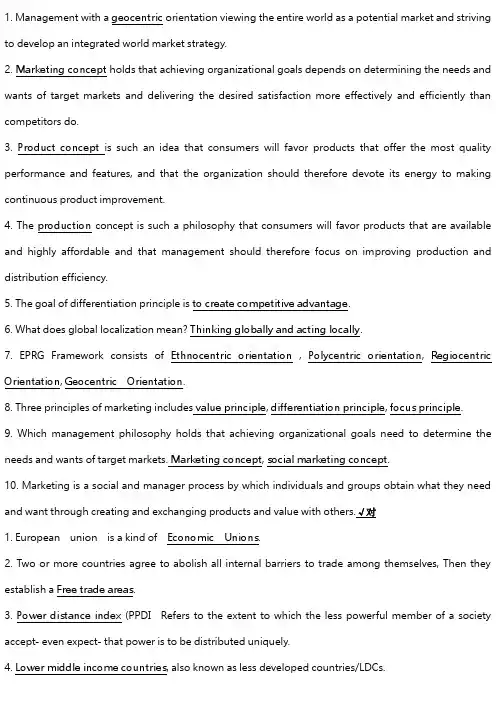
1. Management with a geocentric orientation viewing the entire world as a potential market and striving to develop an integrated world market strategy.2. Marketing concept holds that achieving organizational goals depends on determining the needs and wants of target markets and delivering the desired satisfaction more effectively and efficiently than competitors do.3. Product concept is such an idea that consumers will favor products that offer the most quality performance and features, and that the organization should therefore devote its energy to making continuous product improvement.4. The production concept is such a philosophy that consumers will favor products that are available and highly affordable and that management should therefore focus on improving production and distribution efficiency.5. The goal of differentiation principle is to create competitive advantage.6. What does global localization mean? Thinking globally and acting locally.7. EPRG Framework consists of Ethnocentric orientation, Polycentric orientation, Regiocentric Orientation, Geocentric Orientation.8. Three principles of marketing includes value principle, differentiation principle, focus principle.9. Which management philosophy holds that achieving organizational goals need to determine the needs and wants of target markets. Marketing concept, social marketing concept.10. Marketing is a social and manager process by which individuals and groups obtain what they need and want through creating and exchanging products and value with others.√对1. European union is a kind of Economic Unions.2. Two or more countries agree to abolish all internal barriers to trade among themselves, Then they establish a Free trade areas.3. Power distance index(PPDI Refers to the extent to which the less powerful member of a society accept- even expect- that power is to be distributed uniquely.4. Lower middle income countries, also known as less developed countries/LDCs.5. Expropriation is a kind of political risk.6. High income countries also known as advanced industrialized postindustrial or first world countries.7. Self -reference criterion(SRC) refers to the unconscious reference to one's own cultural values.8. Market Allocation relies on consumers to allocate resources.9. Which of the following belongs to the most of delusion of equity control?Expropriation, Confiscaction, Nationalization, Creeping expropriation.10. In a high context country lawyers is less important , a person's word is his or her bond, responsibility for organizational error is taken by highest level, people breathe on each other.11. Sovereignty refers to the spring and independent political authority of a country.12. There are three types of economic systems, namely capitalist, sociologist, and mixed.13. There are four stages of market development, namely low income countries, lower middle income countries, upper middle income countries, and high income countries.14. Culture can be explained by ways of living built up by a group of human beings which are transmitted from one generation to another.15. Maslow's hierarchy of needs is a useful theory of human motivation that helps explain cultural universals.1. Segmentation is defined as the process of dividing the world market into distinct success of consumers that behave in the same way or have similar needs.2. Demographic segmentation is dividing the world based on measurable characteristics of populations, such as age, gender, income, national income, education and occupation, etc.3. Behavior segmentation focus on whether people buy or use a product, how often and how much they use it.4. Targeting is the act of evaluating and comparing the identified segments in order to select one or more of them as prospects with the highest potential.5. Differentiated global marketing entails targeting two or more distinct segments with different marketing mixes.6. Positioning is the location of a product in the mind of its customers,that is positioning is what happens in the mind of the customer.7. High-tech positioning is a kind of positioning strategy for products which are ppurchased on concrete product features; Bears already have processed or wish to acquire considerable technical Information.8. Core product consists of the core, problem solving benefits that consumers seek when they buy a product.9. Product life cycle is the cause of a product's sales and profits over its lifetime.10. Then company sells exactly the same product or service with the same advertising as used in the home country ,in some or all world market countries or segments, we say the company chooses a dual expansion strategy for global product expansion.11. Transfer pricing refers to the pricing of goods and services bought and sold by operating units or divisions of a single company.12. Price escalation is the increase in a product's price as transportation ,duty and distributor margins are added to the factory price.13. Distribution channel refers to an organized network of agencies and institutions which in combination perform all the activities required to link producers with users to accomplish the marketing task.14. The width of distribution channel is depending on the number of intermediaries in each level of channel.15. Promotion refers to all forms of communication used by organizations to inform ,remaind,explain, persuade, and influence the attitudes and buying behavior of customers and other persons.16. Advertising refers to any sponsored paid message placed in a mass medium.17. The goal of public relations is to build good relations with company's various publics.18. Personal selling is the interpersonal art of the promotion mix, which involves two -way ,personal communication between salespeople and individual customers-whether face to face ,by telephone,through video conferences ,or by other means.19. Sales promotion refers to any consumers or trade program of limited duration that is tangible value to a product or brand.20. The goal of sales promotion is to encourage the purchase our sale of a product or service through the short term incentives.21. ST p refers to segmentation positioning and targeting.22. Consumer products contains of convenience, shopping, specialty ,and unsought products on the basis of how they are purchased.23. Sure, when the design product. We need to consider such factors as preferences, cost, laws and regulations ,compatibility and so on.24. What are the factors influencing price setting? Pricing objectives, competitive prices, demand for the product, cost.25. Which of the following a new product pricing strategies? Market skimming pricing, Market penetration pricing.《国际技术贸易》习题2一、单项选择题1.《马德里协定》生效的时间是()2.国际合作生产的主体()。
1、题目:企业给销往各地市场的产品都制定统一的出厂价格,这是(A)答案A 标准化定价法答案B 主动竞争定价法答案C 地心定价法答案D 多样化定价法2、题目:细分市场是由类似的(C )组成的。
答案A 产品答案B 行业答案C 消费者群体答案D 企业3、题目:(B )是企业把销售市场划分为若干区域,对于不同区域的顾客,分别制定不同的地区价格答案A FOB原产地定价答案B 分区定价答案C 统一交货定价答案D 基点定价4、题目:进口许可证制、进口配额等属于(C)答案A 国有化答案B 外汇管制答案C 进口限制答案D 租税控制5、题目:下列商品中较适宜采用无差异策略的是(B )答案A 服装答案B 粮食答案C 鞋类答案D 化妆品6、题目:从根本上来说,国际营销环境分析就是要研究企业所面临的(C )答案A 经济环境答案B 政治环境答案C 不可控制因素答案D 可控制因素7、题目:国际市场营销与国内市场营销相比,其表现为(A )答案A 两者的理论来源和基础相同答案B 两者的营销方式相同答案C 两者面对的环境相同答案D 两者的营销难度相同8、题目:以下哪种途径获得的信息属于二手资料( D )答案A 通过访谈答案B 通过问卷调查答案C 通过市场试验答案D 通过报纸、刊物9、题目:下列行为中不属于政治干预的是(B )答案A 没收、征用和国有化答案B 外汇管制答案C 政治冲突答案D 本国化10、题目:国际市场资源战略是从产品生产流程中的( A )角度来思考企业的国际市场营销战略的答案A 投入答案B 产出答案C 生产答案D 服务11、题目:关税属于(C )答案A 经济环境答案B 政治环境答案C 法律环境答案D 文化环境12、实施国际市场营销的企业多采用国别市场营销观念,即公司意识到不同国别的市场存在( B )答案A 无差异答案B 差异性答案C 同质化答案D 标准化13、题目:(C )是产品的最基本的层次,是顾客购买的核心内容,是购买者期望从产品中获得的基本利益和效用答案A 期望产品答案B 延伸产品答案C 核心产品答案D 潜在产品14、题目:在国际营销中,短期效果明显的促销方式是(B )答案A 广告促销答案B 营业推广答案C 公共关系答案D 联合促销15、一个国家生活必需品的市场潜量主要取决于(A )答案A 人口的规模答案B 人口的分布答案C 人口的增长率答案D 人口的结构16、题目:下列哪项不能用来降低生产成本?(D )答案A 提高产量答案B 提高生产效率答案C 控制原材料消耗答案D 控制高管人员工资17、题目:最初级的国际市场进入模式是(B)答案A 直接出口答案B 间接出口答案C 契约进入答案D 投资进入18、题目:按照著名经济学家罗斯托的“经济成长阶段论”,当国家经济稳定增长、各种社会设施及人力资源的运用已达到一定的水平,农业及各种产业的现代化水平不断提高,规模逐渐扩大时,该国处于下列经济发展阶段( C )答案A 传统社会答案B 起飞前夕答案C 起飞答案D 趋向成熟19、题目:最高级的国际市场进入模式是(D)答案A 直接出口答案B 间接出口答案C 契约进入答案D 投资进入20、题目:下列哪些产品除(C )外一般都适合于成本加成定价法?答案A 商品房答案B 皮鞋答案C 古董答案D 服装21、题目:国际市场营销是指(A )答案A 各国之间商品交换答案B 向他国出口产品答案C 跨国界的市场营销活动答案D 在某国生产产品22、题目:美国通用电气公司与日本三家公司共同开发原与法国斯索克玛公司共同开发的新一代发动机,这种联盟属于:( C )答案A 市场营销型联盟答案B 资源互补型联盟答案C 联合研制型联盟答案D 共享供应型联盟23、题目:印度、埃及和菲律宾等国经济属于(C )答案A 自给型经济答案B 原料出口型经济答案C 工业化进程中的经济答案D 工业化经济24、题目:出口营销是国际营销的发展阶段之一,一般认为该阶段始于( B )答案A 20 世纪50 年代答案B 20 世纪60 年代答案C 20 世纪70 年代答案D 20 世纪80 年代25、题目:下列不属于非概率抽样方法的是(C )答案A 判断抽样答案B 便利抽样答案C 分层抽样答案D 定额抽样26、题目:市场领导者拓展市场可以通过那种方式实现?(B )答案A 积极防御答案B 市场开发答案C 紧密跟随答案D 重点集中27、题目:能够反映一个国家或地区经济状况和金融政策的综合指标是(B )答案A 自然资源答案B 基础设施答案C 通货膨胀率答案D 外国投资状况28、题目:由航空公司、航空食品企业、旅行社等多个行业的企业共同来完成为顾客提供的航空旅行服务,这种形势所组成的联盟属于:( C )答案A 市场营销型联盟答案B 资源互补型联盟答案C 联合研制型联盟答案D 横向联盟29、题目:在市场细分的基础上,企业将多个细分市场作为目标市场并针对每个子市场分别制定营销组合方案。
《国际市场营销学》练习题一、单项选择题这次发的练习题是将上次发的做了调整的,以这次的为准1.20 世纪 80 年代以后,国际市场营销的发展进入(D)A. 进口营销阶段B. 出口营销阶段C.跨国国际营销阶段D. 全球营销阶段2.国际市场营销学是源于 ( D )A. 经济学B. 国际贸易C.商业企业管理学D. 基础市场营销学3.跨国国际营销是国际营销的发展阶段之一,一般认为该阶段始于( D)A.20 世纪初B.20 世纪 50 年代C.20 世纪 60 年代D.20 世纪 70年代4.世界市场有多种分类方法,把国际市场分为欧洲共同体、独联体、东盟自由贸易区、南美洲共同市场等,这种分类方式是( C)A. 按地理位置分类B. 按经济发展水平分类C.按国际经济联盟分类D. 按出口商品类别及商品分类5.在下列各种国际营销活动过程中可能遇到的不属于政治风险的是( A)A. 汇率变动B. 进口限制C.外汇管制D. 政府没收6.下列关于集中性营销策略的叙述中,说法错误..的是 ( C)A.在一个或几个较小的市场上占有较大的份额B.目标集中在少数几个子市场C.在较大的市场上占有一个较小的市场份额D.适用于资源有限的企业7.企业只推出单一产品,运用单一的市场营销组合,力求在一定程度上适合尽可能多的顾客的需求,这种战略是(A)A. 无差异市场营销战略C.差异市场营销战略B. 密集市场营销战略D. 集中市场营销战略8.下列属于产品附加利益层的是(D)A. 产品的功能和效用C.产品的包装和色彩B. 产品的品牌和商标D. 送货、安装、上门服务9.某企业集团从生产保健品转向房地产开发,其产品市场的进入模式是A. 产品开发型模式B. 市场开发型模式C.市场渗透型模式D. 多种经营型模式( D )10.以向企业管理人员提供有关销售、成本、存货、现金流量、应收账款等企业经营现状信息为主要工作任务的系统是市场营销信息系统中的(D)A. 市场营销情报系统B. 市场决策支持系统C.市场营销分析系统D. 内部报告系统11. 在国际营销活动中,遇见的最严重的政治风险是(C)A. 外汇管制B. 劳工政策C.没收D. 进口限制12. 国际市场宏观细分的首要步骤是(A)A. 确定细分标准B. 初步划分子市场C.分析初分子市场D. 选择易进入的子市场13. 差异性营销策略的优点是(B)A.实现规模经济,降低生产和营销成本B.增加企业竞争能力,扩大销售额C.集中力量向某一特定子市场提供最好服务D.适用于资源比较有限的企业14.适合选择短渠道销售决策的产品是( B )A.服务要求不高的产品B.销售数量大、购买次数少的产品C.企业销售力量较弱的产品D.重量轻、体积小的产品15.产品处于成长期和成熟期阶段所采用的广告策略主要是(C)A. 告知性广告C.提醒性广告B. 说服性广告D. 让利性广告16.目标市场是指企业所选定的(B)A. 销售地区B. 消费者群体C.销售渠道D. 销售产品17.在商品价格构成要素中,最基本、最主要的因素是( A)A. 成本B.需求C.供给D.购买力18.在分析国际市场政治环境时,衡量政治不稳定性的指标除了文化分裂外,还有( D )A. 没收B. 征用C.宗教冲突D. 政权的更迭率19.如实反映企业经营状况的调查研究属于(B)A. 探索性研究B. 描述性研究C.因果性研究D. 预测性研究20.由调查人通过亲自观看或用仪器进行记录的一种调查方法是(B)A. 询问法B. 观察法C.实验法D. 问卷法21.某产品在市场上普及并逐渐达到饱和,销售量趋于稳定,这说明该产品处于产品生命周期中的(C)A. 投入期B. 成长期C.成熟期D. 衰退期22.企业各产品线中产品项目的数目的平均数称为产品组合的(C)A. 广度B. 长度C.深度D. 密度23.促销活动的首要任务是(D)A. 推销产品B. 留住顾客C.树立形象D. 传递信息24.以自己的名义在本国市场上购买商品,再卖给国外买主的贸易商,统称为(C)A. 出口代理商B. 出口佣金商C.出口商D. 企业自设出口机构25.从企业微观经济分析,市场的构成要素有消费者、欲望和(D)A. 商品B. 货币C.收入D. 购买力26.国际市场营销主要着眼于(C)A. 国家利益B. 地区利益C.企业利益D. 消费者利益27 能够反映一个国家或地区经济状况和金融政策的综合指标是( C )A. 自然资源B. 基础设施C.通货膨胀率D. 外国投资状况28.对企业市场营销活动中因自变量的变化引起因变量变化的关系进行的研究是(C)A. 探索性研究B. 描述性研究C.因果性研究D. 预测性研究29.国际市场宏观细分标准中,最常用的细分标准是(A)A. 地理标准B. 文化标准C.经济标准D. 政治和法律标准30. 随行就市定价法属于(C)A. 成本导向定价法B. 需求导向定价法C.竞争导向定价法D. 心理导向定价法31、以“新产品—现有需求—国际市场”为基本思路的国际产品市场进入模式是(C)A. 多种经营型模式B. 市场渗透型模式C.新产品开发型模式D. 市场开发型模式32.产品的功能和效用属于整体产品概念中的(B)A. 产品附加利益层B. 产品核心层C.产品有形特征层D. 产品无形特征层33.国际市场的“产品—市场矩阵”中,基于“现有产品—新需求—国际市场”的营销模式是( C)A. 市场渗透模式B. 产品开发模式C.市场开发模式D. 多种经营模式34.顾客需求的差异性理论是( C )A .商品差异性的基础B .市场差异性的基础C.市场细分的基础 D .消费品细分的基础35.产品生命周期中,基本特征为销量低且增长缓慢时,说明产品处于(A)A .投入期B .成长期C.成熟期 D .衰退期36.针对消费者的消费心理,可采用的定价策略是(C)A .盈亏平衡定价法B .边际成本定价法C.尾数定价法 D .平均成本定价法37.不拥有产品所有权,在规定条件下向国外市场销售商品的中间商是(A)...A .出口代理商B .出口经销商C.出口采购商 D .出口经纪人38.国际市场营销与国际贸易都有的工作是(B)A. 促销B.组织进出口业务C.国际上商品交换D.产品开发39.如果需要把本公司具有优势的知识和技能进行国际转移,其主要媒介是(B)A. 出口打入模式B.合同打入模式C.投资打入模式D.间接出口40.产品的维护属于(D)A. 产品的核心层B.产品的有形特征层C.产品的延伸层D.产品附加利益层41.美国通用汽车在中国大陆有“别克”、“雪佛兰” 等不同的品牌号,这种决策是(C)A. 统一品牌决策B.分类品牌决策C.多品牌决策D.主、副品牌决策42.在商品流通过程中,对商品没有..所有权的是( C)A. 中间商B.经销商C.代理商D.消费者43.所谓渠道管理的中心任务就是要( B )A. 降低成本B.解决矛盾C.提高效率D.促进协调44. 在制定国际市场促销策略时,最基本的决策是(B)A. 决定促销在国际营销中的强度B. 识别 / 估测目标受众C.提出购买建议D. 决定最优促销组合45. 下列促销手段中,属于营业推广的是(C)A. 广告B. 人员推销C.有奖销售D. 公共关系46. 下列关于影响国际市场销售渠道决策因素的说法中,正确的是(B)A. 产品单价越低,越应选择短渠道B. 新产品问市之初应选择短渠道C.体积大的重型产品应选择长渠道D. 技术性强的产品应选择长渠道47.当商品的需求弹性系数E D值>l 时,表明该商品是 (A)A. 富有弹性B. 缺乏弹性C.无弹性D. 不能确定弹性48.企业的订货、销售量、生产量、价格、存货等信息属于(C)A. 市场情报系统B. 市场运筹学系统C.内部记录系统D.国际市场研究系统49.将公司的产品在目标国家之外制造,然后运往目标国家市场销售,这种进入国际市场的式称为(D)A. 契约进入模式C.产品进入模式B. 投资进入模式D.出口进入模式50.产品的品质和价格属于(B)A. 产品核心层B. 产品有形特征层C.产品无形特征层D.产品附加利益层51.适宜采用“生产者→零售商→消费者”销售渠道的产品是( A. 农产品类 B. 汽车类B)C.日用品类D.能源类52.短渠道策略适宜于(A)A. 销售量很大、购买次数少的市场B. 销售量很大、购买次数多的市场C.销售量很少、购买次数少的市场D.销售量很少、购买次数多的市场53.对于顾客挑选性强、注重品牌商标的产品,其销售渠道宽度应选择的策略是(D)A. 广泛销售策略B. 密集销售策略C.选择性销售策略D. 独家销售策略54.通货膨胀对于国际营销决策影响最大的是(B)A. 产品决策B. 定价决策C.分销决策D. 促销决策55.如实了解企业产品销售增长率状况的市场研究属于(B)A. 探索性研究B. 描述性研究C.因果性研究D. 预测性研究56.某汽车制造厂有载重车、牵引车、小轿车等产品线,则其产品组合的宽度为(C)A.1B.2C.3D.457. 在世界市场中处于中等竞争地位的企业常采用的跨国公司市场竞争战略是(C)A. 市场领导者战略 B. 市场挑战者战略C.市场追随者战略D. 市场后起者战略58.如果某个国家规定商标所有权以最先注册者优先取得,则这个国家采用的法律是(D)A.国际法系 B.国际商标法系C.习惯法系 D.成文法系59.为了明确某一问题的性质、情况和原因等而进行的专项研究属于(A)A.探索性研究B.描述性研究C.因果性研究D.预测性研究60.某产品的销量迅速增长,企业开始盈利,竞争者纷纷加入,这说明该产品处于产品生命周期中的 (B)A.投入期B.成长期C.成熟期D.衰退期61.企业生产或经营的产品线数目称为产品组合的(A)A.宽度 B.长度C.深度 D.密度62.适宜市场追随者采用的定价策略是(D)A.薄利多销策略B.按质论价策略C.最优价格策略D.随行就市策略63.较少采用人员推销方式进行促销的产品是(A)A.低价消费品B.高价消费品C.低价工业品D.高价工业品64.国际市场营销渠道是指商品从一个国家的生产企业流向(B) A.国外供应商的流程B.国外最终消费者或用户的流程C.国外代理商或经纪人的流程D.国外生产企业的流程65.下列定价法中不属于心理导向定价策略的是...A.声望定价法C.优质优价法66.下列活动中不属于营业推广活动的是(...A.有奖销售C.公共关系( B) B.整数定价法D.尾数定价法C)B. 赠券D.分期付款67.国内出口中间商类型很多,其中不拥有产品所有权的出口中间商是( A)...A. 出口代理商B. 国际贸易公司C.出口直运批发商D. 国外设在本国的常驻收购商68.能够体现及时调整信息、实现信息双向交流等特点的促销手段是(A)A. 人员推销B. 广告C.营业推广D. 公共关系69.对于在国外开展营业推广活动的公司来说,应重点考查法律限制、中间商的能力和( A)A. 竞争者的作法B. 企业自身能力C.产品的特点D. 消费者的购买行为70.价格低廉、产品差异很小、购买量小而频率高的日常消费品的出口常采用( B )A. 集中销售策略B. 广泛销售策略C.选择性销售策略D. 独家销售策略71. 产品处于导入期和成长初期时,应采取的广告策略是(B)A. 说服性广告策略B. 告知性广告策略C.提醒性广告策略D. 诱导性广告策略二、多项选择题1.进入国际市场模式有 (ABC)A. 出口打入模式B. 合同打入模式C.投资打入模式D. 技术打入模式E.管理打入模式2.出口代理商的主要类型有( ABC)A. 出口经营商B. 厂商出口代理人C.国际经纪人D. 出口佣金商E.企业自设出口机构3.企业在分析要进入的国家和地区时,首先要分析其市场规模和容量,具体而言,要分析的因素主要有(A)A. 人口B. 收入C.商业服务能力D. 城市化水平E.经济发展水平4.契约进入模式的内容包括(.ABDE)A. 特许B.许可证贸易C.技术转让D.合同生产协议E.“交钥匙”合同5.一般外销企业在销售渠道宽度上可供选择的策略有(ACE)A. 广泛销售策略B.一般性销售策略C.选择性销售策略D.非选择性销售策略E.独家销售策略ADE)6.在国际市场的产品——市场矩阵中,市场开发型模式的决定因素有(A. 现有产品B. 现有市场(现有需求)C.新产品D. 新市场(新需求)E.国际市场7.国际市场的定价目标主要有利润目标、市场目标和竞争目标,其中市场目标主要包括(.ABCDE)A. 质量优异目标B. 增加销售量目标C.市场占有率目标D. 市场渗透目标E.稳定价格目标8.促销信息传播的方式主要有(ABCE)A. 人员推销B. 广告C.公共关系D. 宣传E.营业推广9.国际市场营销与国际贸易的区别在于( ABCDE)A. 市场主体B. 理论基础C.生产经营特征D.利益机制E.商品交换范围10.下列属于国际市场文化环境的是(ACD )A. 语言B. 教育C.价值观和态度D.宗教E.国际关系11.信息传播的方式主要有 ( ABDE)A. 人员推销B. 广告C.产品包装D.营业推广E.公共关系12.国际市场研究的类型主要有(ABC)A. 探索性研究B. 描述性研究C.因果性研究D.调查性研究E.预测性研究13.对国际市场进行细分需要遵循的原则是( ABCD)A. 差异性B. 可进入性C.可衡量性D.可收益性E.可保护性14.跨国企业制定较高或较低转移价格的作用主要有(.ABCDE)A. 减少税负B. 规避风险 C 争夺与控制市场D.转移资金E.调节子公司的利润水平15 对国际市场分销渠道成员控制与管理的手段主要有(ABCDE)A. 人员培训B. 激励C.提供优惠的信贷条件D.评估E.中止16.国际市场信息系统包括(ABD)A .内部记录系统B .营销情报系统C.反馈评价系统 D .营销调研系统E.营销决策支持系统17.进入国际市场的投资打入模式主要有(AB)A. 独资经营B. 合资经营C.合同制造D.劳务合作E.合同生产协议18.选用长渠道销售的产品特点主要有(ACD)A. 单价低B. 技术性强C.重量轻D.不易毁损E.服务要求高三、简答题1.简述宗教对国际营销活动产生重要影响的原因。
2020年自考《国际市场营销学》试题及答案(卷一)一、单项选择题(本大题共20小题,每小题1分,共20分)在每小题列出的四个备选项中只有一个是符合题目要求的,请将其代码填写在题后的括号内。
错选、多选或未选均无分。
1.企业能生产什么就生产什么,能生产多少就生产多少,这种经营观念叫做(D)P16A.市场营销观念B.推销观念C.社会市场营销观念D.生产观念2.社会市场营销观念的基础是(CP17)A.生产观念B.推销观念C.市场营销观念D.计划观念3.在一国国际收支项目中,国际工商企业一般情况下最关注的项目是(A)P56A.经常项目B.资本与金融项目C.官方储备项目D.错误与遗漏项目4.进出口商品经过一国关境时,由政府所设的海关对进出口商品所征的税收称为(A)P69A.关税B.所得税C.营业税D.增值税5.用一组与某产品在潜在需求量密切相关的变量来间接地估计该产品可能的需求量的方法,叫(B)P103A.类比估计技术B.多因素指标技术C.回归分析技术D.风险评估技术6.国际市场营销调研的最后一个环节是(D)P92A.问卷设计B.二手资料搜集C.数据分析D.撰写调研报告7.格特•霍夫施塔德提出从几个方面进行跨文化分析(C)P119-P120A.2个B.3个C.4个D.5个8.欧盟政府部门采购大约占其国内生产总值的(A)P135A.20%B.25%C.30%D.40%9.现代市场营销学研究的主要内容是以什么为主的市场营销组合(B)A.3PsB.4PsC.5PsD.6Ps10.市场细分化是由谁于20世纪50年代提出的营销概念(A)P136A.温德尔•史密斯B.马斯洛C.霍夫施塔德D.蒙代尔11.企业给销往任何市场的产品都制定统一的出厂价格,这种定价法叫做(D)P215A.地心定价法B.竞争导向定价法C.成本加成定价法D.标准化定价法12.倾销是指企业将出口销售价格定得(C)P218A.高于“合理的价值”B.等于“合理的价值”C.低于“合理的价值”D.低于生产成本13.除了那些财力雄厚的企业以外,一般中小企业适宜(D)P229A.自己投资建立分销渠道B.直接将产品销售给最终用户C.将产品交给政府去销售D.利用中间商来销售商品14.一般来说,国际分销渠道的设计直接影响和决定企业对国际市场营销的(B)P231A.依赖程度B.控制程度C.预测准确程度D.熟悉程度15.直接影响企业在公众心目中的形象,影响着企业市场营销目标市场的实现的国际促销方式之一是(D)P278A.国际广告B.人员推销C.营业推广D.国际公共关系16.国际上最古老的、所有的企业都十分重视的促销方式是(A)P276A.展览会和交易会B.博览会C.商品交易所D.人员促销17.有关国际营销的各项经营活动计划的总和,叫做(C)P293A.国际营销策略B.国际营销战略C.国际营销划D.国际营销控制18.企业要根据对国外市场的分析选择准备进入的国际市场,这就是(A)P147A.目标市场选择B.目标市场定位C.目标市场细分D.目标市场调研19.与市场营销的全球化对应的必然是(C)P324A.贸易全球化B.生产全球化C.品牌全球化D.产品组合多样化20.成员国相互取消贸易障碍,进行某种程度的合作与协作,以促进成员国之间的贸易经济发展,这就是(A)P302A.区域经济集团化组织B.世界贸易组织C.关税同盟D.共同市场二、多项选择题(本大题共5小题,每小题2分,共10分)在每小题列出的五个备选项中至少有二个是符合题目要求的,请将其代码填写在题后的括号内。
第1章国际市场营销理论基础习题一、选择题1.下列有关交换的说法哪个是正确的?()A.人们要想获得所需要的产品,必须通过交换B.交换是一个结果而不是一个过程C.交换也就是交易的另一种说法D.交换是人们获得自己所需要的某种产品的一种方式2.1984年,科特勒提出了市场营销的新概念,即()A.大市场营销B.直接市场营销C.关系市场营销D.全球市场营销3.市场营销运行的基本要求是:一切经济活动都要围绕()而进行。
A.企业B.市场营销C.等价交换D.市场4.哪种观念下容易出现“市场营销近视”?()A.生产观念B.推销观念C.产品观念D.社会市场营销观念5.市场营销组合的4Ps是指()A.价格、权力、地点、促销B.价格、广告、地点、产品C.价格、公关、地点、产品D.价格、产品、地点、促销6.在买方市场条件下,一般容易产生()A.推销观念B.生产观念C.市场营销观念D.社会市场营销观念E.产品观念7.现代市场营销的构架形成于()A.20世纪初B.20世纪20年代C.二次大战后D.20世纪60年代8.下列关于关系市场营销的论述不正确的是:()A.关系市场营销就是通过不正当途径搞市场营销B.关系市场营销是交易市场营销的一种方式C.关系市场营销没有交易市场营销公平D.关系市场营销认为保持老顾客比吸引新顾客更重要9.为了适应社会对于环境保护的要求,许多企业主动采取绿色包装以降低白色污染。
这种做法反映了企业的:()A.社会营销观念B.销售观念C.市场观念D.生产观念10.关系营销的核心概念是建立()的长期关系:A.企业与顾客B.企业与供应商C.业与分销商D.企业与经销商11.下列哪种说法是正确的?()A.市场营销者可以通过市场营销活动创造需求B.需要就是对某种产品的需求C.市场营销者可以通过营销活动影响人们的欲望,进而影响人们的需求D.有了欲望,需求自然产生12.许多冰箱生产厂家近年来高举“环保”、“健康”旗帜,纷纷推出无氟冰箱。
国际市场营销学(二)试卷(2009年7月)第一部分选择题(满分25分)一、单项选择题(本大题共15小题,每小题1分,共15分)在每小题列出的四个备选项中只有一个是符合题目要求的,请将其代码填写在题后的括号内。
错选\多选或未选均无分。
1.企业为满足市场需求并获得利润而进行的与市场有关的经营活动,我们称之为( ) C(P1)A.战略管理 B.企业管理C.市场营销 D.企业策划考查市场营销的定义。
市场营销是指企业为满足市场需求并获得利润而进行的与市场有关的经营活动。
2.市场细分这个营销概念的提出者是( ) A(P,136)A.温德尔·史密斯 B.李嘉图C. 俄林 D.凯恩斯考查市场细分。
市场细分是由温德尔·史密斯教授于20世纪50年代提出的营销概念。
市场细分是实现目标营销的基础,目的在于识别哪些企业能集中资源和力量、赢得竞争优势的市场。
3.麦当劳、肯德基这样的国际著名企业成功地进人国外市场的模式,是( ) C(P157) A.许可贸易 B.合同制造C.特许经营 D.管理合同A.投入期 B.成长期C.成熟期 D.衰退期考查合同进入模式中的特许经营方式。
特许经营是企业(特许方)向特许接受者提供商标、商号和经营模式,容许销售其商标的产品,并收取使用费。
在实践中,许多国际著名的企业,例如麦当劳、肯德基都是以特许经营成功地开拓大量外国市场的。
6.政府的影响与限制是影响国际营销定价的:C(P202)A.公司因素、B.产品因素C.环境因素D.市场因素考查营销国际营销定价的环境因素。
环境因素包括政府的影响与限制、货币的波动、商业周期的阶段、通货膨胀的水平等。
7。
对产品的定价影响最直接、构成产品成本主要部分的是()C(P204)A.税收B.储运费用C.技术授权方式D.创牌方式考查产·品的成本结构对定价的影响。
产品生产费用,也即制造费用,是产品成本的主要部分,对产品定价的影响最直接。
而税收、储运费用、中间商毛利等也是国际营销定价要考虑的重要因素,但不是最直接的因素。
《国际市场营销》试题及答案第一套题 A卷(答案已验证)★单选题:BDDDA/ACADD1.“酒香不怕巷子深”反映的营销观念是 A、生产观念 B、产品观念 C、推销观念 D、社会营销观念2.强调企业要与顾客、经销商创造更亲密的工作关系和相互依赖的营销观念是 A、推销观念 B、市场营销观念 C、社会营销观念 D、关系营销观念3.下列哪部分收入是国际消费需求变化中最活跃的因素 A、该国国民收入 B、该国人均国民收入 C、该国个人可支配收入 D、该国个人可任意支配收入4.市场定位的4C不包括下面哪个因素 A、客户 B、销售渠道 C、竞争 D、环境5.在进入某一国家的市场之前,必须首先考虑其 A、政治是否稳定 B、市场是否足够大 C、科技是否发达 D、基础设施是否齐全6.具有共同目标或兴趣的两个或两个以上的人联结而成的群体被称为 A、群体 B、参考群体 C、向往群体 D、厌恶群体7.一个人推崇效仿的,期望成为其中一员或与之交往并受其影响的群体被称为 A、群体 B、参考群体 C、向往群体 D、厌恶群体8.人们确信的对某种事物的看法和评价被称为 A、信念 B、学习 C、气质 D、个性9.下列哪个因素对组织购买行为基本不产生影响 A、环境因素 B、组织因素 C、个人因素 D、生产因素10.下面对国际市场营销环境特点的叙述错误的是 A、客观性 B、差异性 C、相关性 D、静态性★多选题:>ABCD/ BDE/ ABCDE/ ADE/ ABCE//ABD/ ABCD/ ABCDE/ ABC/ ABCD1.下列对国际市场生产者市场特点的叙述正确的是 A、购买者地理分布相对集中,购买者较少但购买量较大 B、属于派生需求 C、属于理性需求 D、一般属于全球采购 E、需求富有价格弹性2.以顾客为中心的观念主要有 A、生产观念 B、产品观念 C、推销观念 D、市场营销观念 E、社会营销观念3.企业在开展国际市场营销活动时要发挥主观能动性,必须做到 A、从积极主动的角度出发,能动地去适应国际营销环境 B、以各种不同的方式增强适应国际环境的能力,避免来自国际营销环境的威胁 C、在变化的环境中寻找自己的新机会,并可能在一定的条件下转变环境因素 D、努力去影响和改变营销环境,为企业创造一个更有利的活动空间 E、努力使营销活动与国际营销环境取得有效适应4.人口对市场规模大小的影响主要表现在 A、人口总量是决定市场规模和潜力的一个基本要素 B、人口增长率不是预测市场前景的一个重要指标 C、人口分布状况对产品需求、促销方式、分销渠道都不会产生影响 D、人口年龄结构、性别结构影响着市场的需求结构 E、家庭结构影响着产品的设计与包装5.下列关于供应商的叙述正确的是 A、供应商是影响企业营销的微观环境的重要因素之一 B、供应商是指企业及其竞争者提供生产产品和服务所需资源的企业或个人 C、供应商影响供货的稳定性与及时性 D、企业在寻找和选择供应商时,不会充分考虑供应商的资信情况 E、企业必须使自己的供应商多样化6.技术革命特别是信息技术发展对国际营销的影响主要表现在 A、因特网已经成为国际营销中满足消费者需求最具魅力的营销工具 B、可以有效降低国际交易的费用和交易风险 C、不利用技术革命对产品实施技术创新 D、随着技术的发展,时间成为决定产品策略成败的关键 E、不会影响着国际市场的竞争的内容7.通常状况下影响国际组织市场购买行为的主要因素有 A、国际环境因素 B、组织本身的因素 C、组织人际因素 D、个人因素 E、非个人因素8.人们在一项购买决策过程中可能充当如下角色 A、发起者 B、影响者 C、决策者 D、购买者 E、使用者9.下面对国际生产者市场特点的叙述正确的是 A、非最终消费产品 B、技术性强 C、批量采购 D、最终消费产品 E、技术性不强10.消费者市场具有如下特点 A、发展性 B、多层次性 C、可诱导性 D、复杂多变性 E、替代性★是非题:>NNYYN/YYYNY1.以市场营销观念作为企业营销活动的指导思想就要求企业放弃赢利目标。
1 国际贸易理论基础第七章国际市场营销 一、单项选择题(下列每题的选项中,只有一个是正确的,请将其代号填在括号内) 1.市场是由一切具有特定的欲望和需求并且愿意和能够以( )来满足此欲望和需求的潜在顾客组成。 A.合作 B.控制 C.组织 D.交换 【答案】D 2.( )是一个社会管理过程,在这个过程中个人和群体通过创造、提供、与他人交换有价值的产品而满足自身的需要和欲望。 A.市场推销 B.合作经营 C.市场营销 D.客户服务 【答案】C 3.企业国际营销战略必须服从于企业( )战略的要求。 A.国际贸易 B.国际经营 C.国际化 D.国际市场 【答案】B 4.多国化营销战略的目标是( ) A.占据国际市场 B.占据全球市场 C.占据多个不同的国外市场 D.占据一个国家多个市场 【答案】C 5.将业务集中于少数国家的少数细分市场的战略称( )。
A.市场专门化战略 B.区域集中战略 C.多元化战略 D.集中化战略 【答案】D 6.企业在进入某一国外市场后对该国的顾客进行的细分称为( )。
A.国际市场细分 B.国际市场组合细分 C.国际市场宏观细分 D.国际市场微观细分 【答案】D 7.企业把全部或多数子市场作为目标市场,并为不同的子市场设计不同的营销组合方案的营销策略称( )。
A.无差异性营销策略 B.差异性营销策略 C.集中性营销策略 D.分散性营销策略 【答案】B 8.企业所选定作为营销对象的具有某些特定需要的消费者群体称为( )。
A.细分市场 B.目标市场 C.市场主体 D.营销对象 【答案】B 2
9.消费者对产品的质量、款式、价格等有不同的要求,而且对企业同一营销策略会做出不同的反应的市场,称为( )。 A.卖方市场 B.买方市场 C.异质市场 D.同质市场 【答案】C 10.顾客对产品的需求大致一致,而且对企业同一营销策略反应也十分相似的市场称为( )。 A.卖方市场 B.买方市场 C.异质市场 D.同质市场 【答案】D 11.有较大的营销风险的营销策略是( )。 A.无差异性营销策略 B.差异性营销策略 C.分散性营销策略 D.集中性营销策略 【答案】D 12.目标营销的基础是( )。 A.市场细分 B.营销环境 C.营销组合 D.营销计划 【答案】A 13.文化的主要影响因素是( )。 A.教育 B.语言 C.宗教 D.价值观 【答案】C 14.市场细分的概念依据是( )。 A.顾客需求的同质理论 B.顾客需求的异质理论 C.营销目标的同质理论 D.营销目标的异质理论 【答案】B 15.家庭规模对于市场营销具有重要参考价值,因为家庭规模小,家庭数目多,就意味着( )。
A.消费品市场潜力小 B.工业品市场潜力小 C.消费品市场潜力大 D.工业品市场潜力大 【答案】C 16.用经济标准划分世界市场的一个最简单的方法是将( )作为衡量指标。
A.国民生产总值 B.国内生产总值 C.人均国民生产总值 D.国民生产净值 【答案】C 17.如果企业经营的是钢铁、粮食、煤炭等彼此差异不大的产品,则采用( )目标营销策略较合适。
A.分散性 B.集中性 C.差异性 D.无差异性 【答案】D 18.出口进入国外市场的经营对象主要是( )。 A.消费品 3
B.有形商品 C.无形商品 D.服务 【答案】B 19.产品的功能属于( )。 A.产品的形体层 B.产品的有形特征层 C.产品的核心层 D.产品的附加利益层 【答案】C 20.产品生命周期是指( )。 A.从生产制造到退出市场 B.从生产制造到废品回收 C.从投入市场到废品回收 D.从投入市场到退出市场 【答案】D 21.销售迅速增长,企业开始赢利。同时快速扩张的产品市场和收益刺激其他厂商,吸引竞争者纷纷介入,新产品这一生命周期阶段是( )。 A.投入期 B.成长期 C.成熟期 D.衰退期 【答案】B 22.下列哪种国际产品策略需要花费巨大的成本( )。 A.产品和宣传的双重改变 B.产品延伸,宣传改变 C.产品改变,宣传保持 D.设计并开发全新产品 【答案】D 23.企业生产或经营的产品线数目称( )。 A.产品项目 B.产品组合 C.产品组合的广度 D.产品组合的深度 【答案】C 24.国际消费品开发策略能最大限度地节省成本的是( )。
A.国际产品标准化策略 B.国际产品相对标准化策略 C.国际产品当地化策略 D.国际产品本国化策略 【答案】A 25.有些经营汽车的跨国公司兼并摩托车企业,生产摩托车,实行的是( )。
A.专业化发展 B.同心多样化 C.水平多样化 D.混合多样化 【答案】B 26.构成容量很大的现实市场,必须是( )。 A.人口众多而且购买力高 B.购买力高而且购买欲望大 C.人口众多而且购买欲望大 D.人口众多购买力高而且购买欲望大 【答案】D 27.对消费者的购买行为具有最为广泛、最深远影响的因素是( )。
A.个人因素 B.社会因素 C.文化因素 4
D.心理因素 【答案】C 28.国际市场定位工作不包括下列哪一选项( )。 A.战略定位 B.产品定位 C.形象定位 D.营销定位 【答案】D 29.国际营销企业选择目标市场所考虑的第一因素是( )。 A.文化差异 B.市场规模 C.营利性 D.销售额 【答案】B 30.同质产品或需求共性较大的产品,宜采用( )。 A.无差异市场营销战略 B.差异市场营销战略 C.集中市场营销战略 D.大量市场营销战略 【答案】A 二、多项选择题("FYEJ每题的选项中,至少有两个是正确的。请将其代号填在括号内) 1.从竞争的角度来区分,国际营销战略有( )。 A.产品竞争战略 B.服务竞争战略 C.广告竞争战略 D.市场竞争战略 E.企业形象战略 【答案】ADE 2.从国际化程度不同区分,国际经营战略有( )。 A.一国化战略 B.多国化战略 C.集中化战略 D.国际化战略 E.全球化战略 【答案】BDE 3.关于国际化营销战略,正确的有( )。 A.目标是进入国际市场 B.产品来源于国内制造商 C.营销重心仍在国内 D.由国内市场向国际市场扩展 E.目标是占据多个不同的国外市场 【答案】ABCD 4.关于多国化营销战略,正确的有( )。 A.目标是占据多个不同的国外市场 B.国外市场与国内市场并重 C.营销重心多元 D.产品在不同市场地域就地生产 E.目标是进入国际市场 【答案】ABCD 5.关于全球化营销战略,正确的有( )。 A.目标在全球市场 B.以全球观点来看待各国市场 C.必须定期制定与修正国际战略及其规划 D.实现跨国营销管理 E.目标是进入国际市场 【答案】ABCD 6.全球公司实行全球营销的依据是( )。 A.国际交通通信的现代化 B.经济的全球化 5
C.国际市场的统一化 D.国际市场需求的相似性 E.营销管理的一致性 【答案】ABC 7.市场扩展与定位战略包括的基本战略有( )。 A.集中化战略 B.区域集中化战略 C.市场集中化战略 D.国别集中化战略 E.多元化战略 【答案】ABCE 8.消费品市场的细分标准有( )。 A.家庭规模 B.家庭生命周期 C.生活方式 D.购买频率 E.消费模式 【答案】ABCDE 9.工业品市场的细分标准有( )。 A.生产企业 B.政府部门 C.中间商 D.用户地理位置 E.用户规模 【答案】ABCDE 10.关于无差异性营销策略,正确的有( )。 A.认为没有必要划分市场 B.用一种标准化的营销组合策略 C.可以增加企业的竞争能力 D.可以实现规模经济效益 E.忽视消费者差异性 【答案】ABDE 11.关于集中性营销策略,正确的有( )。 A.目标市场集中在一个或少数几个市场上 B.中小企业采用此策略 C.适用资源有限的企业 D.可以降低经营成本 E.有较大风险 【答案】ABCDE 12.制定产品/市场进入策略的要素包括( )。 A.目标产品/市场的选择 B.目标市场的对象和任务 C.目标市场的进入模式的选择 D.目标市场的市场营销计划 E.国际营销的控制系统 【答案】ABCDE 13.合同进入模式的内容包括( )。 A.许可证贸易 B.特许 C.技术转让 D.合同制造 E.管理合同 【答案】ABCDE 14.出口进入模式的内容包括( )。 A.间接出口 B.直接代理商 C.直接经销商 D.直接分公司 E.直接子公司 【答案】ABCDE 6
15.不适于采用无差异营销策略的商品有( )。 A.化肥 B.服装 C.化妆品 D.粮食 E.药品 【答案】BCE 16.关于衰退期产品的阐述正确的有( )。 A.销量下降 B.价格下跌 C.利润减少 D.竞争品增多 E.企业应发展新产品取代老产品 【答案】ABCDE 17.关于“国际产品生命周期”正确的有( )。 A.此概念是美国雷德蒙•弗农提出的 B.是产品牛命周期理论在国际市场上的运用 C.它的四个阶段是针对创新国而言,而不是针对整个国际市场 D.说明了国际产业结构的变化和转移 E.利用不同市场差异,国际产品生命周期可延长 【答案】ABCDE 18.关于产品差异化,正确的有( )。 A.属大量价格竞争策略 B.是相对于产品标准化的一个概念 C.指企业生产出独特产品 D.改变产品赋予消费者的期望 E.扩大产品赋予消费者的期望 【答案】BCDE 19.关于产品多样化策略正确的有( )。 A.是相对于产品专业化的概念 B.使消费者从同一厂商处能购买到不同种类和型号的产品
C.同心多样化策略 D.纵向一体化策略 E.复合多样化策略 【答案】ABCDE 20.从市场竞争战略选择上看,企业可追求的目标有( )。
A.市场领导者 B.市场防御者 C.市场挑战者 D.市场控制者 E.市场追随者 【答案】ACE 21.企业选择目标营销策略应考虑的因素有( )。 A.企业资源条件 B.产品同质性 C.产品生命周期 D.市场同质性 E.竞争对手的营销策略 【答案】ABCDE 22.国际营销中市场细分的主要作用是( )。 A.利于发掘新的市场机会 B.利于针对目标市场制订适当的营销方案 C.可使企业获得规模效益 D.可使企业获得竞争优势 E.可使企业适应资源有限这一特点 【答案】ABD 23.需求是指人们对某个产品有( )。 A.爱好